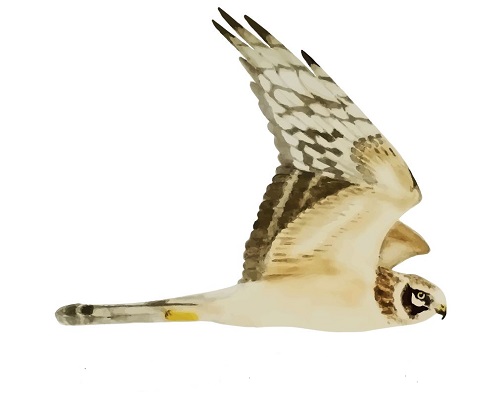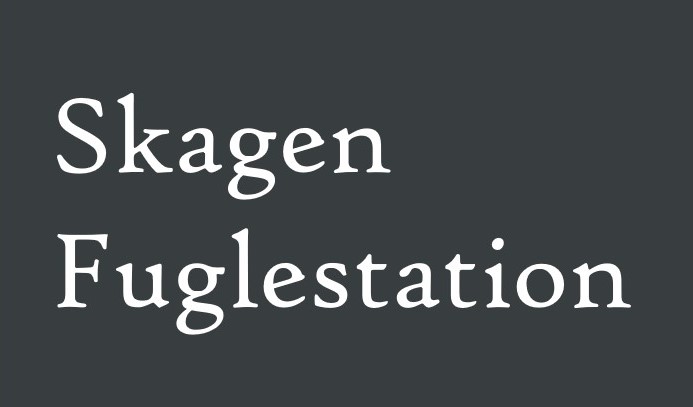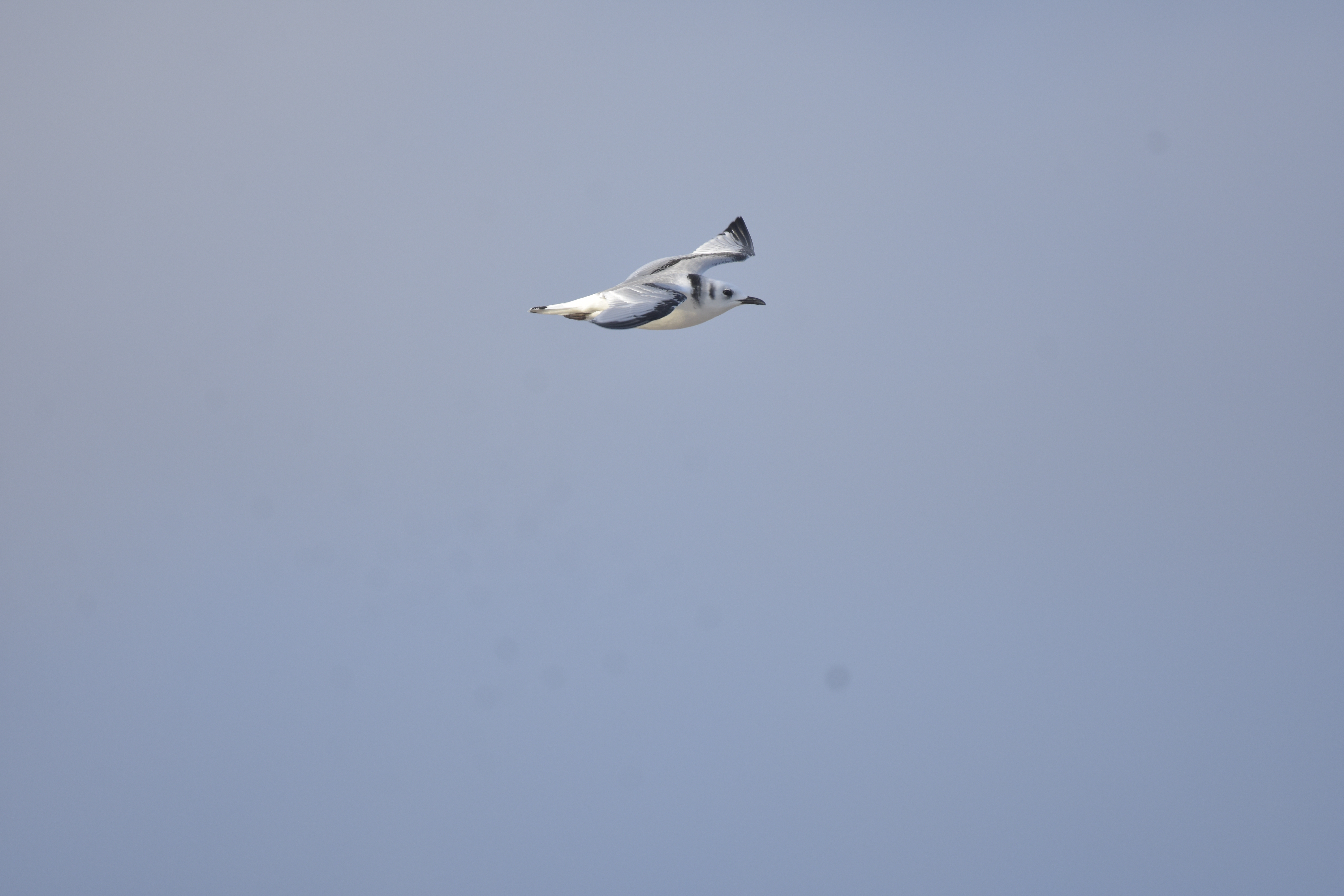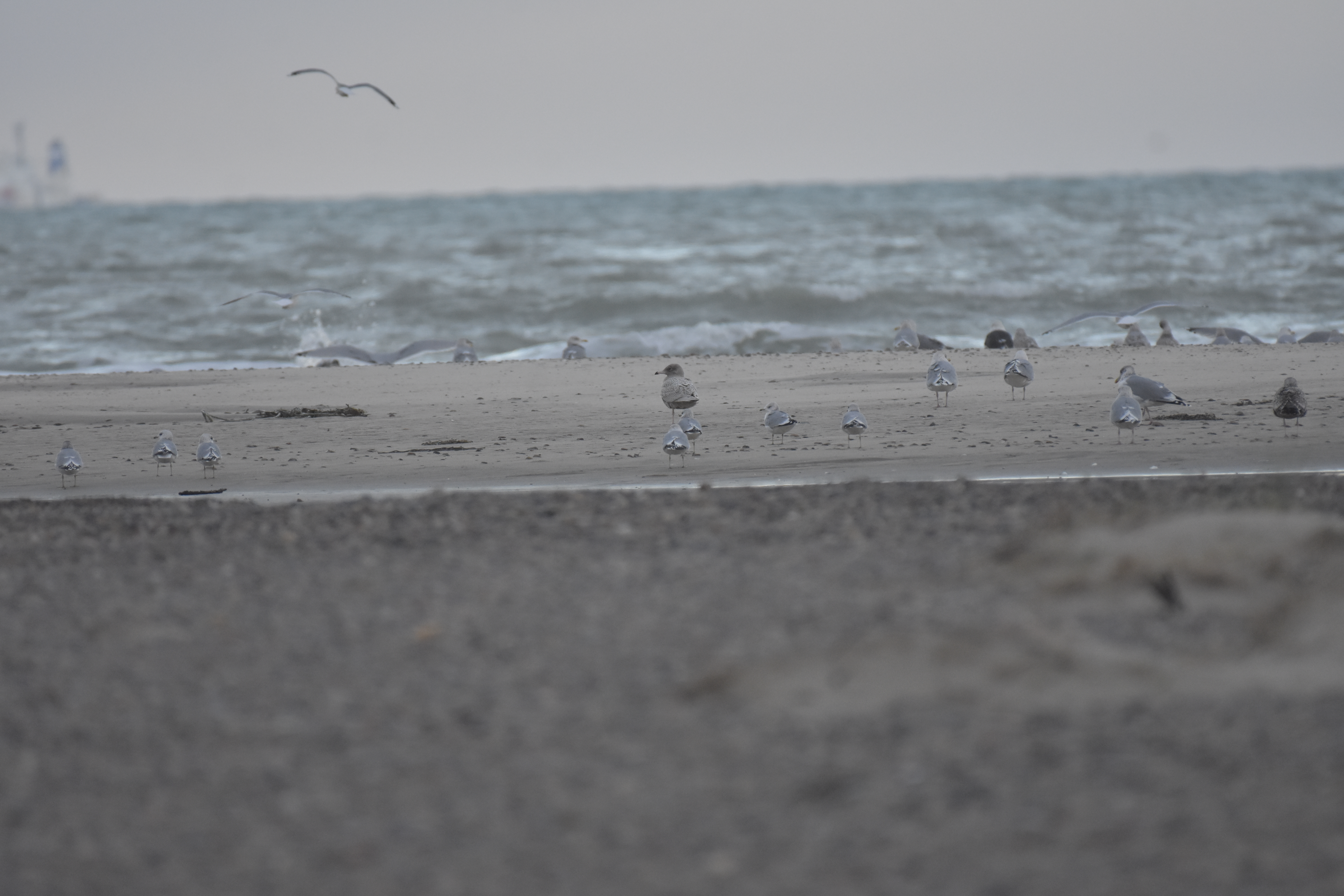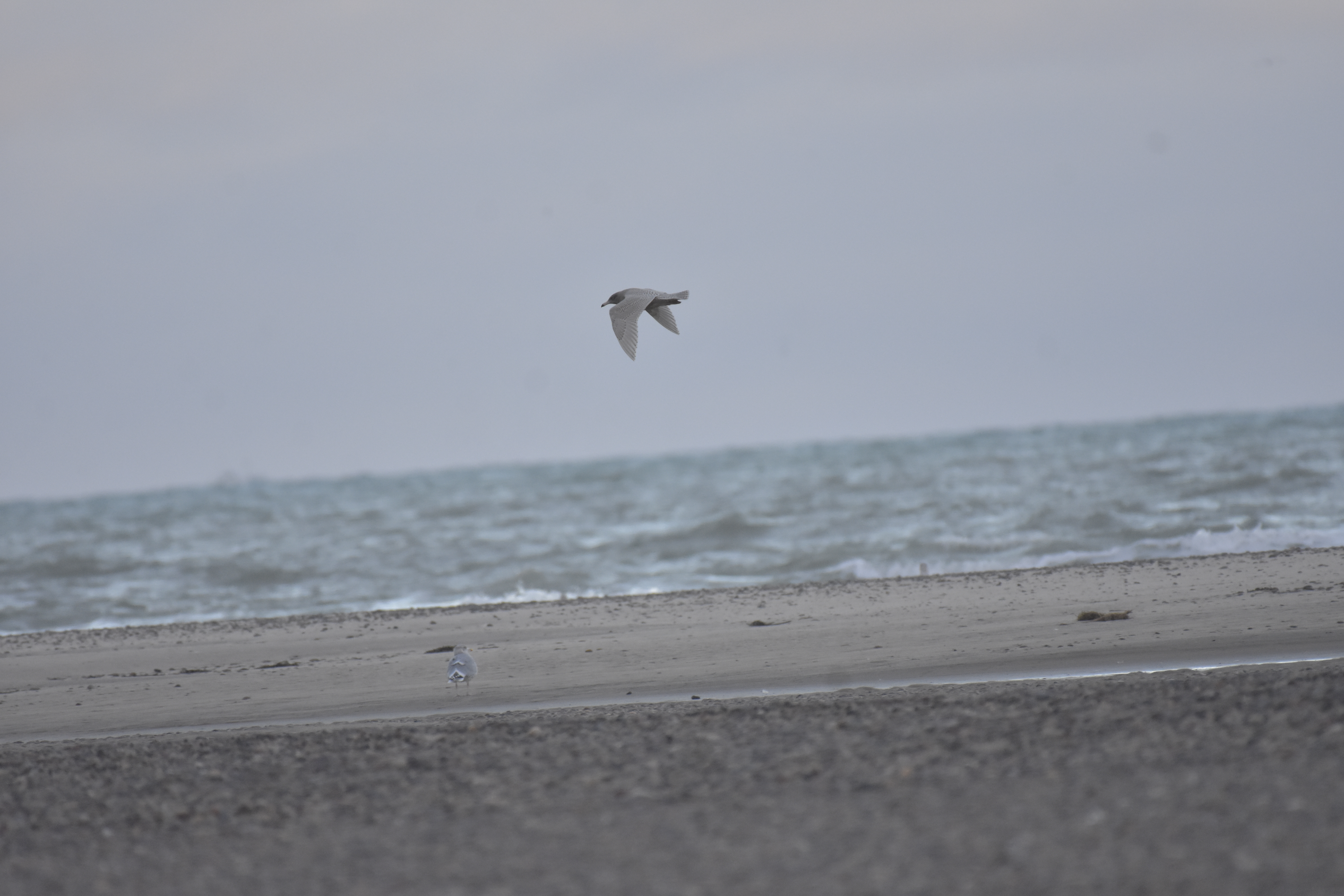Her på Skagen Fuglestations blog bringes korte nyheder i dagbogsformat om hændelser på fuglestationen.
Se indlæg fra måned: feb. (16)mar. (30)apr. (30)maj (31)juni (30)juli (31)aug. (31)sept. (30)okt. (31)nov. (29)dec. (11)
A Day of Exploring & Baking
Pinch, punch, first of the month and not only the countdown until Christmas but also the countdown until the closing of Skagen Fuglestation for another year.
The day started with an additional, unofficial for the bird obs data, migration count being undertaken by Ragnar, Mara, and Alfred. The observations were slow with highlights being the gulls. In fact, 10 Black-headed gulls (Hættemåge), 155 Common gulls (Stormmåge), 825 Herring Gulls (Sølvmåge), 105 Great Black-Backed Gulls (Svartbag), and 9 Caspian Gulls (Kaspisk Måge) all recorded. Other bits and bobs included Mara finding a surfing Hooded Crow (Gråkrage), a migrant female Blackbird that came in from the sea, as well as a Carrion Crow (Sortkrage).
Meanwhile, after a lie-in and nice breakfast Eleanor and I popped on the waders (as you do) and went on an adventurous cycle ride to find some species away from World’s End 3/Grenen and explore some of the more niche Skagen sites.
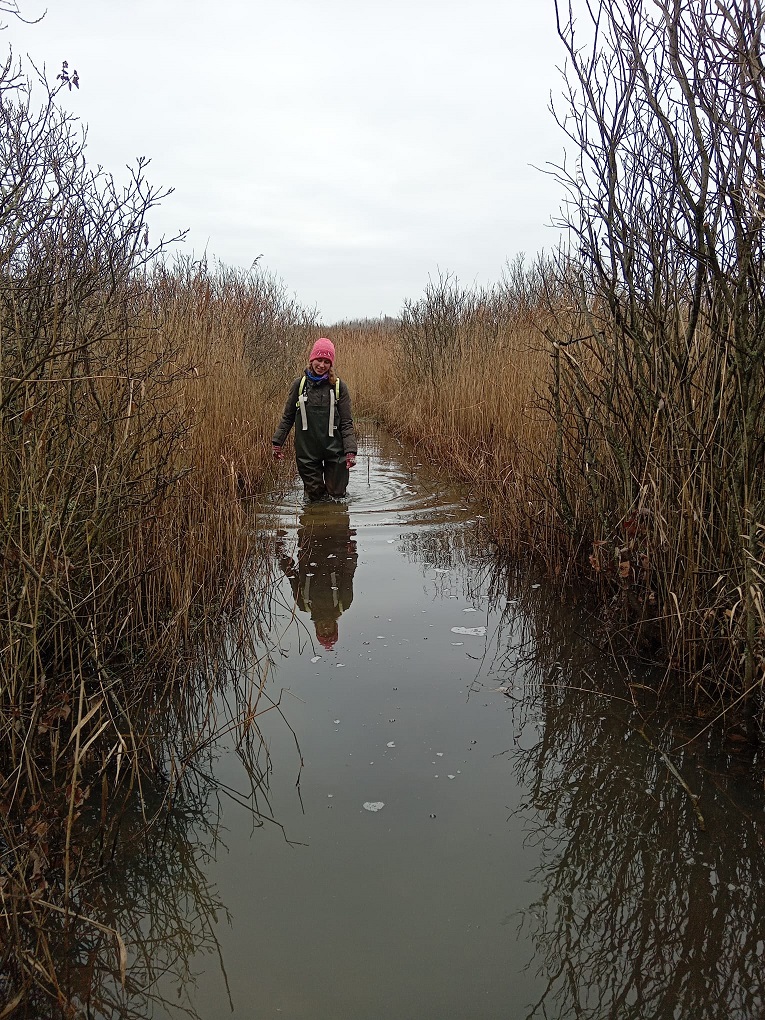
Eleanor in the reeds.
The first was to Kabeltromlen to explore the reeds. This was the first time Eleanor experienced the Kabeltromlen reedbed net round and found it very enjoyable. We found a flock of Bearded tits (Skægmejse), a flock of Chaffinches (Bogfinke), a few Blue tits (Blåmejse), and a couple of Goldcrest (Fuglekonge) too.
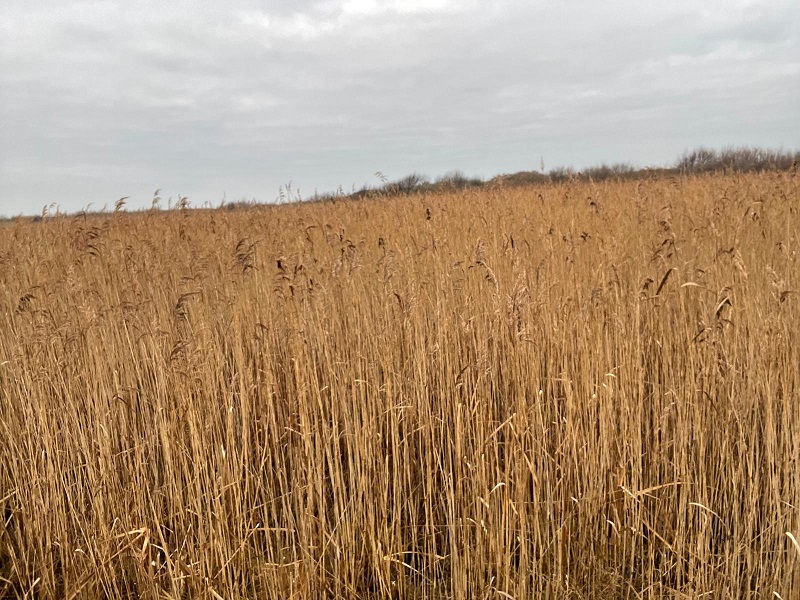
Golden Reedbeds
The reeds were as beautiful as ever and it was nice to wander round the net rounds since closing a few weeks ago. Emerging from the reedbed, we bumped into Eric and it was great to have a birdy chat together whilst cycling back towards the observatory. We parted ways and went to Elle Krattet where we saw a couple of Blackbirds (Solsort) and almost went the wrong way... but our journey continued to Jennes Sø. The lake was calm and out of the wind so a great spot to stop, watch and listen. We heard a Crested tit (Topmejse), saw a female type Hen Harrier (Blå kærhøg) quartering around the moorland, and the rarest of them all, a Kingfisher (Isfugl). A scarce species in the Skagen area and nice to see a flash of blue on a grey day. Light was fading quick so a cycle back along the boardwalk and sandy paths to the observatory was super lovely in the wind. We hiked up the lighthouse and sat watching the sunset from the top. It was a cloudy, windy evening but the lighthouse light beamed the area. We were encouraged to have a wander along the beach and noticed the tide was high and the water was coming up to only a few metres from the bottom of the closest dunes.
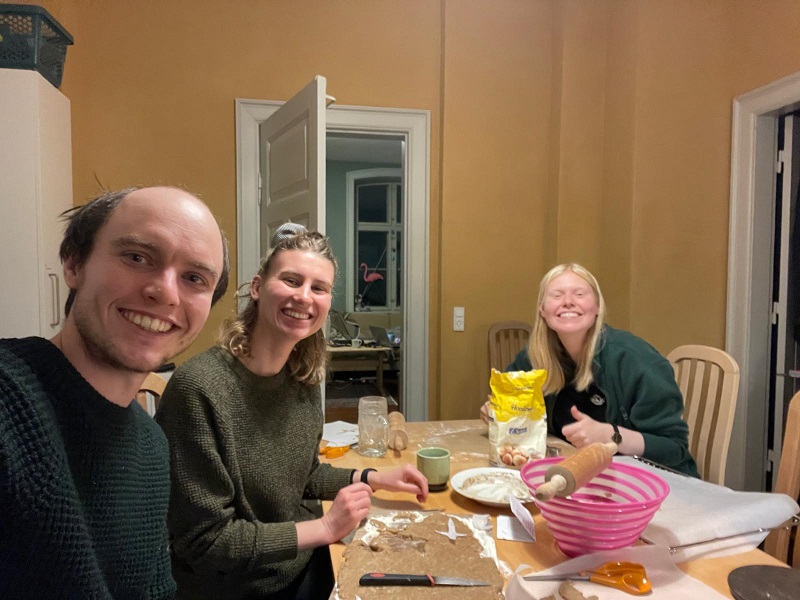
The baking crew
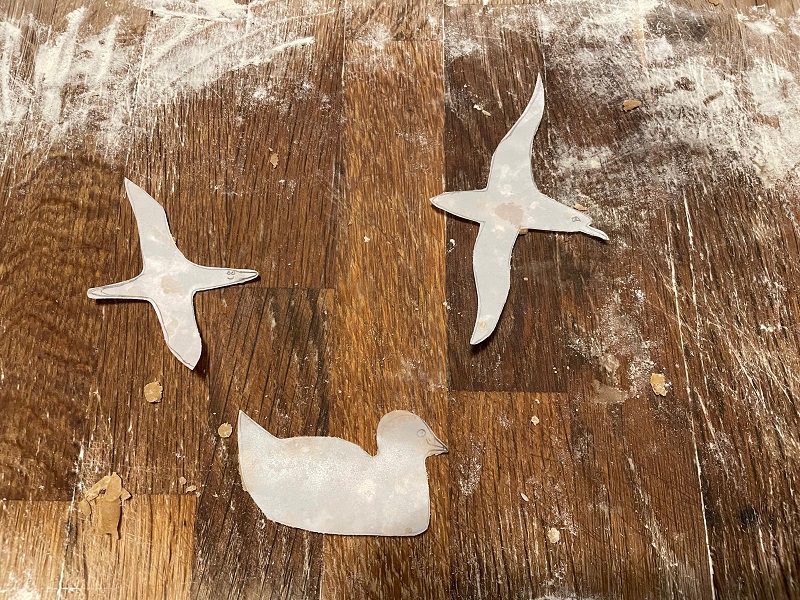
Our bird-shaped seabird makeshift cutouts for gingerbread baking
Arriving back to the observatory, we joined Mara in the kitchen for some Glogg and a baking session. Between the three of us, we made seabird shaped gingerbread, Jødekage, Zimtsterne, and Husarenkrapfen. This was good fun, and the treats went down a treat! This was followed by a tasty risotto cooked by Mara. A cosy evening followed ahead of tomorrow’s adventures.
Highlights from the observatory:
- Kingfisher (Isfugl)
Ringing totals
Jennes Sø
|
Blackbird |
Solsort |
1 |
|
Greenfinch |
Grønirisk |
1 |
|
Wren |
Gærdesmutte |
1 |
Overall total: 3
Today’s observations on Dofbasen from observers in the area
People: Thomas Weston, Eleanor Harris, Mara Glane, Ragnar Smith, Eric Christophersen & Alfred Godsk Geckler.
Migration counts come to a close
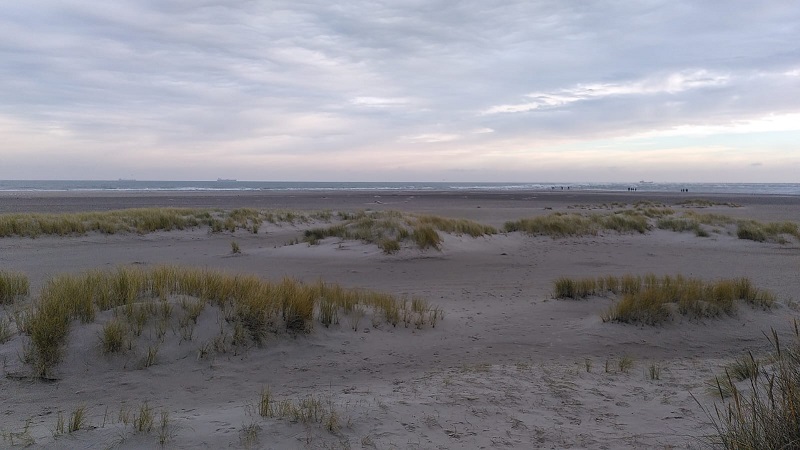
The final migration count by Mara
The day started with the last migration count of the season. Migration was done this morning by Ragnar, Mara, and Alfred. Alfred is joining the team for the weekend and is a very passionate young birder keen to learn more and develop his skills in the field. Migration was slow and the highlights were a Little auk (Søkonge), this was Alfred’s first and all of the team had a clear view. Migration was cut short as the weather started to close in, so all headed back for lunch and a chill but productive afternoon. With this being the last migration count of the season, Ragnar has been the most dedicated and has completed 480 hours battling the weather and the sandy conditions since the summer.
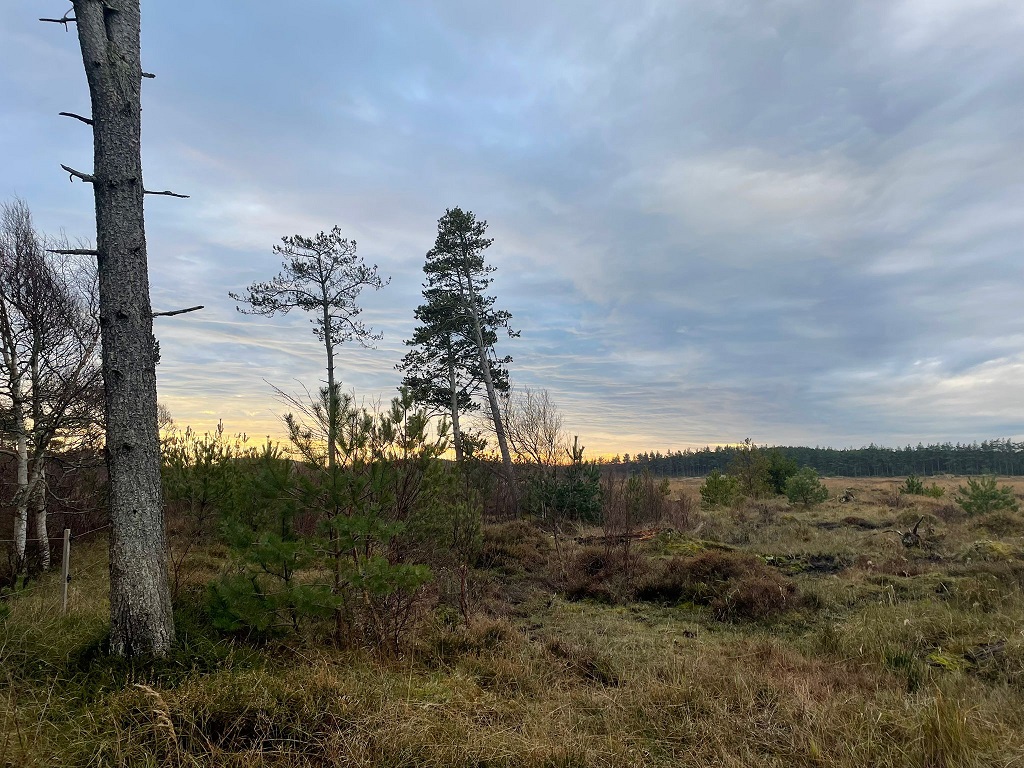
Stockmillen
Meanwhile, Thomas and I went on a cycle ride in the sunshine to Stockmillen and went for a walk. Exploring the area was so lovely and we went on a beautiful walk through a pine wood and the dunes also getting a little distracted by a sweet and excitable dog who came running through the sand dunes to greet us. We saw Crested tit (Topmejse), Goldcrest (Fuglekonge) and Coal tit (Sortmejse). The weather was rather atmospheric with moody and dramatic skies moving through. This later turned to rain when we cycled back to Skagen and took a short detour to shelter in a bakery for sweet treats and tea and hot chocolate.
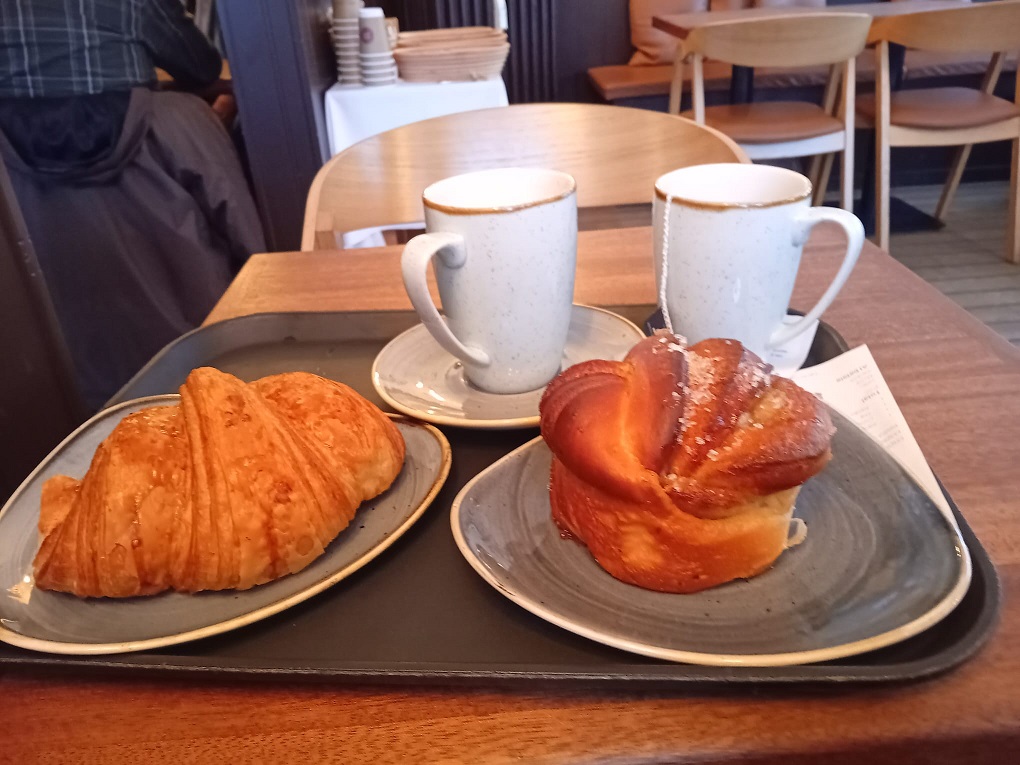
Pastry lunch
The croissants and cardamom buns were good and shortly got demolished. After some food we went for an explore of Skagen then headed back in the rain to warm up with even more tea.
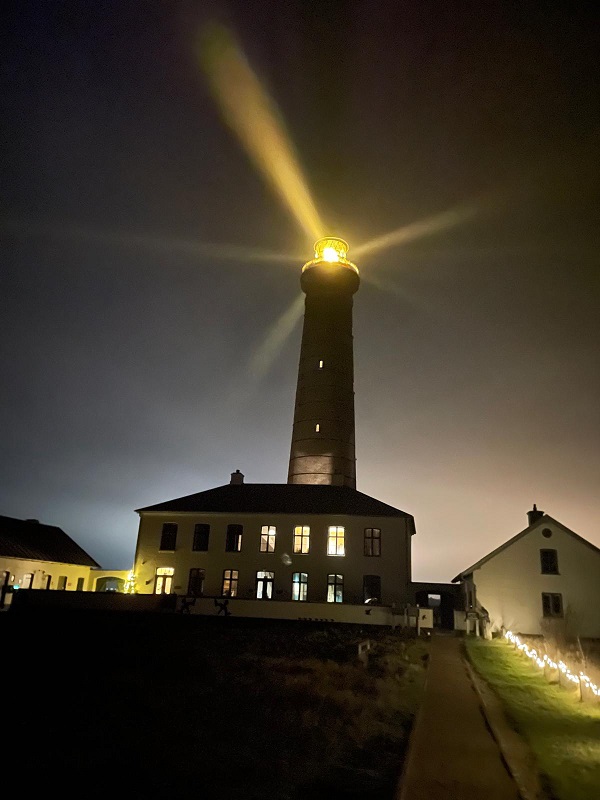
Det Grå Fyr
After a chill but productive afternoon cleaning, we are all chilling whilst Ragnar cooks dinner. It has been a successful day for all and a nice way to finish November off. Here is a photo of the lighthouse looking rather atmospheric this evening as darkness descends.
Highlights from the observatory:
- Little Auk (Søkonge)
Ringing totals
Jennes Sø:
|
Blue tit |
Blåmejse |
1 |
|
Great tit |
Musvit |
2 |
|
Greenfinch |
Grønirisk |
2 |
|
Redpoll (ssp. cabaret) |
Gråsisken, Lille (ssp. cabaret) |
6 |
|
‘Northern’ Bullfinch |
Dompap, Stor (ssp. pyrrhula) |
1 |
Overall total: 12
Today’s observations on Dofbasen from observers in the area
People: Eleanor Harris, Thomas Weston, Mara Glane, Ragnar Smith & Alfred Godsk Geckler.
Bread or fish
Hej!
Motivated and packed in multiple layers of clothing, all four of us ventured out to do the migration count today. Knud also joined us a little later. We settled, nice and comfy on the dune, with the wind thankfully not blowing in our faces, but coming from the south. Migration of Scoters, Kittiwakes/Ride and Alcids was good for the first hours, but declined quickly, simultanious with out feet and hands starting to freeze. The only real highlight today was a Great Skua/Storkjove. I was actually able to identify it, before the others spotted it, this is a first for me and I am really happy about that :). The rest of the migration count was quiet birdwise and after scanning through the gulls and our final hour we packed up and went back to the station.
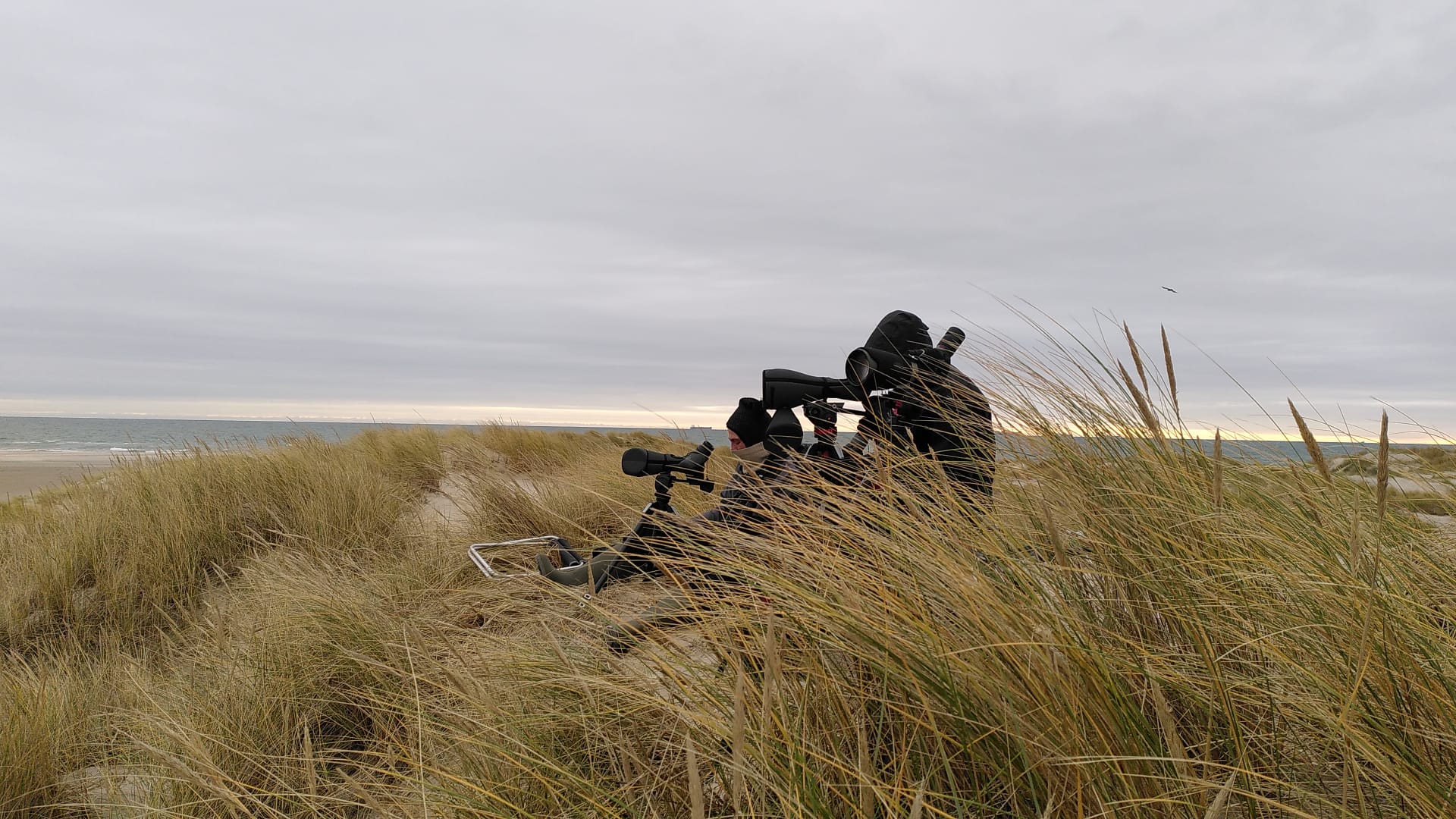
Scopes up at World's End 3
It started raining just as we got back, so our plans of going to the harbour had to be prosponed a little. Thomas, Eleanor and I went on our way as soon as the rain stopped. We got to the harbour as it was already getting dark. Gull feeding was fun nevertheless and someone even turned on the big lanterns for us. Attracting the gulls was another challenge as we had quite the competitor on the other side of the harbour. A huge concentration of gulls was forming around some workers loading up a trolley with fish. Only some of the gulls noticed us throwing out the bread and even fewer decided that bread is potentially nicer than the fish. Among the Herring Gulls/Sølvmåge that listend to our calls was one Caspian Gull/Kaspisk Måge and a couple of Black-headed Gulls/Hættemåge. We called it a success and went on into the city.
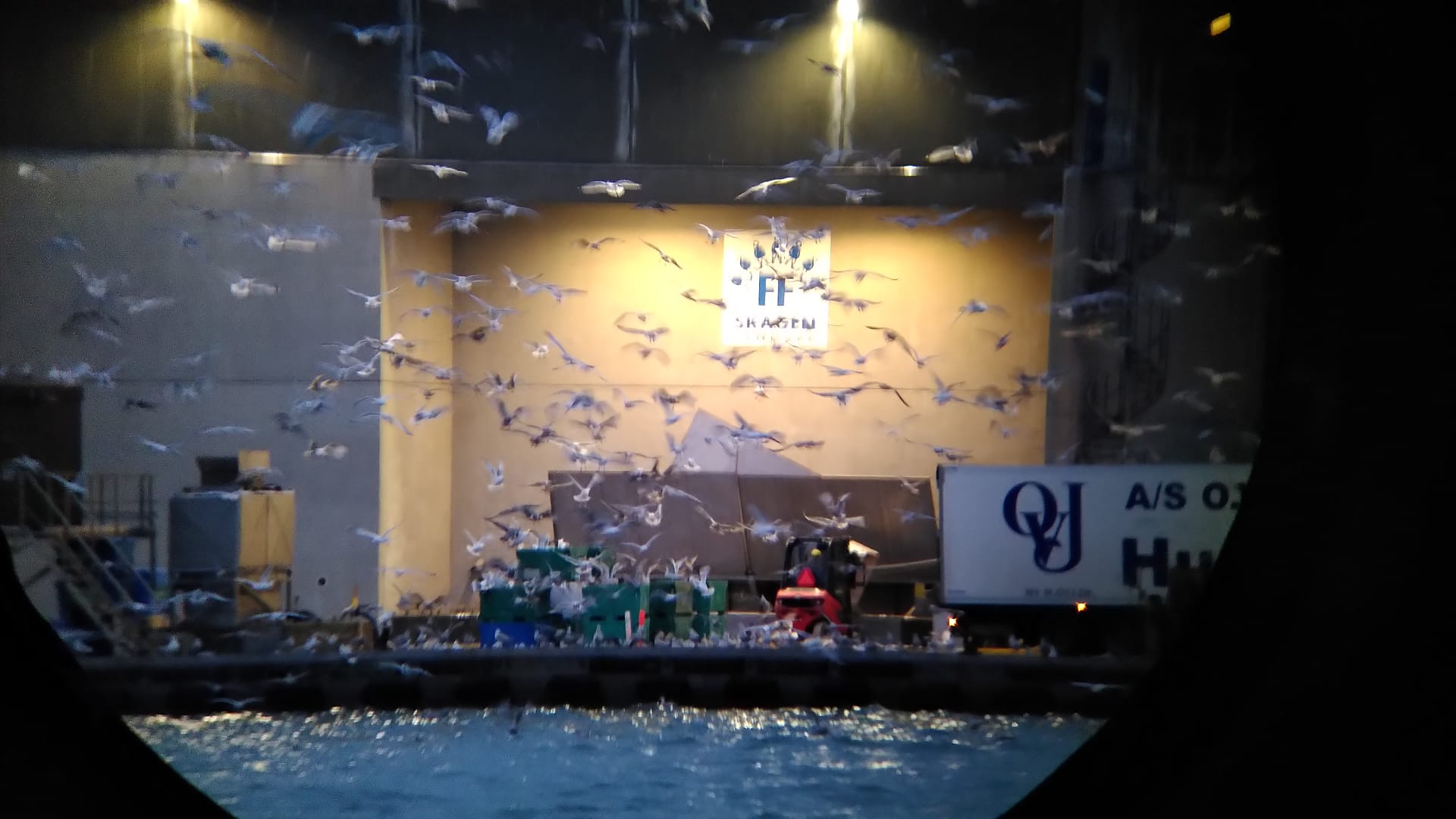
Our strong competitor in attracting gulls - spied on through binoculars
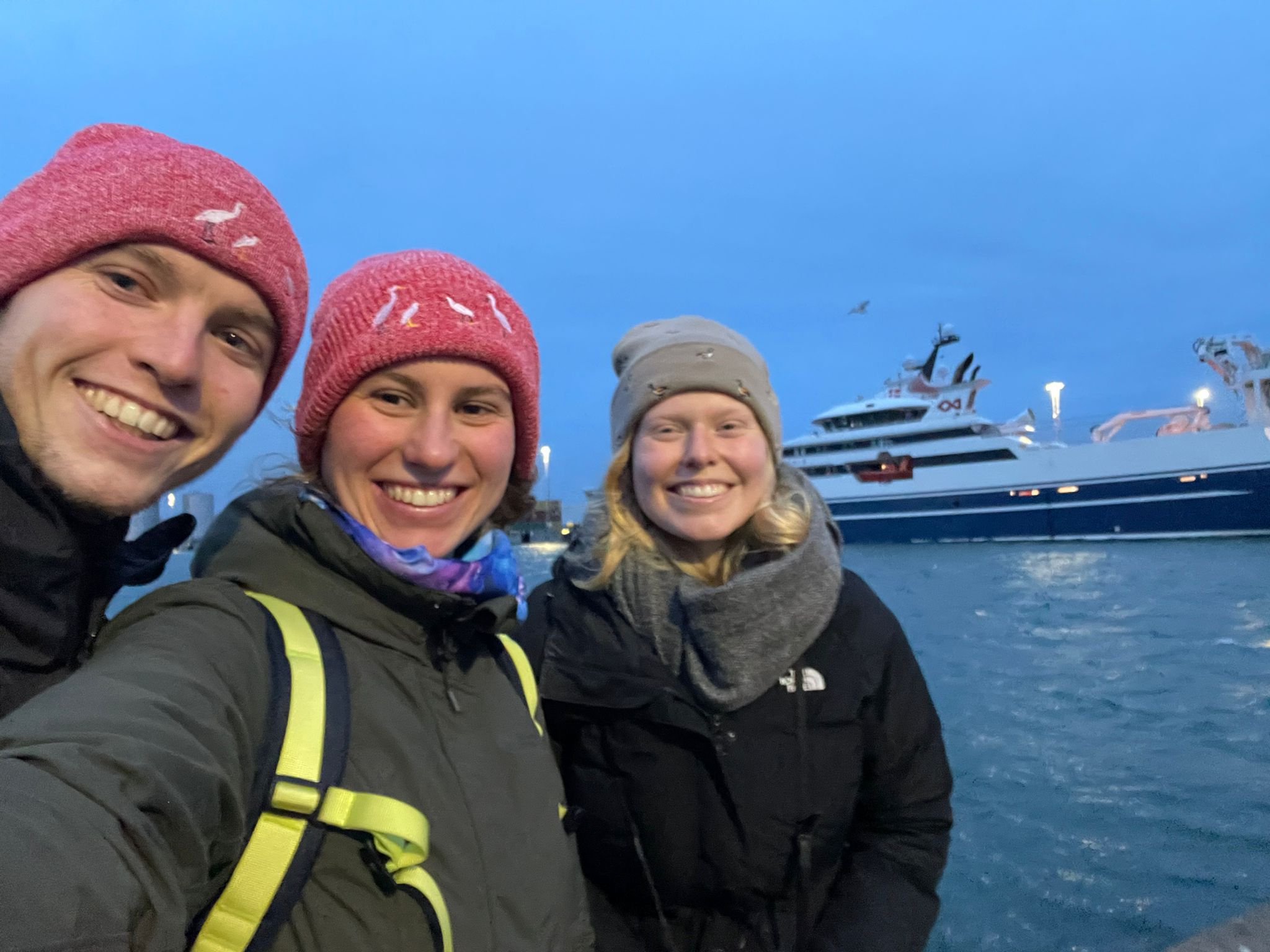
Always a fun activity feeding the gulls
Now that it was proper dark, we could enjoy all the christmas lights that lit up the shopping street and in the store we bought some stuff for our christmas bakery on sunday. On the way to the store, Eleanor almost crashed though a window into a bank, but luckily there was a pillar in the way. Reckless driving - not with us, we only hit pilars, curbs and forklifts (almost).
On our way back to the lighthouse, we saw a Short-eared Owl/Mosehornugle flying over the fields. So I tried catching it. I opended a net in the lighthouse garden and played the owl's calls. I felt a little bit creeped out, while I was waiting behind a nearby bush in the dark, alone.... I saw the owl flying for a brief moment, but it never found its way to the net. Maybe next time.
Highlights from the observations:
Great Skua/Storkjove - 1
Caspian Gull/Kaspik Måge - 6
Ringing (Jennes Sø - Michael Ancher):
Rødhals - 1
Gransanger - 1
Fuglekonge - 1
Musvit - 1
Træløber - 1
Nordlig Gråsisken - 1
Lille Gråsisken - 2
Stor Dompap - 1
Gulspurv - 1
Total = 10
Today’s observations on Dofbasen from observers in the area
People: Thomas Weston, Eleanor Harris, Mara Glane, Ragnar Smith, Knud Pedersen.
A Wild Autumnal Day
The day started with a nice lie in, oooh yeah, it was a good one! This was all whilst Emma left for Copenhagen early this morning and whilst Ragnar endured the first hour of migration counts in the moderate northernly wind but dry conditions that lingered throughout the day. In this hour Ragnar had already seen a Little Auk (Søkonge), a nice selection of Auk spp (Alk, Lomvie, Alk/Lomvie), a few passage Gannets (Sule) and a slight stream of Kittiwake (Ride).
We arrived at the start of the second hour to help with the counts. There was a decent number of Gannets (Sule), with a steady passage totalling ~25 birds, there was a strong passage of Red throated divers (Rødstrubet Lom) and a slight movement of Fulmar (Mallemuk) in the distance. Other standout highlights included two 1st calendar year Glaucous Gulls (Gråmåge), one Black-throated Diver (Sortsturbet Lom) and a very distant Sooty Shearwater (Sodfarvet Skråpe).
Eleanor got a little cold so headed back. Eric joined the migration counts and the last couple of hours. Migration slowed and there were only single figures of Gannet (Sule), Common Scoter (Sortand), Guillemots (Lomvie) and Razorbills (Alk). The hundreds of gulls on the beach kept us entertained and in total there were 4 Caspian Gulls (Kaspisk Måge) within the flock, as well as colour ringed Herring (Sølmåge) and Great-Black Backed Gulls (Svartbag).
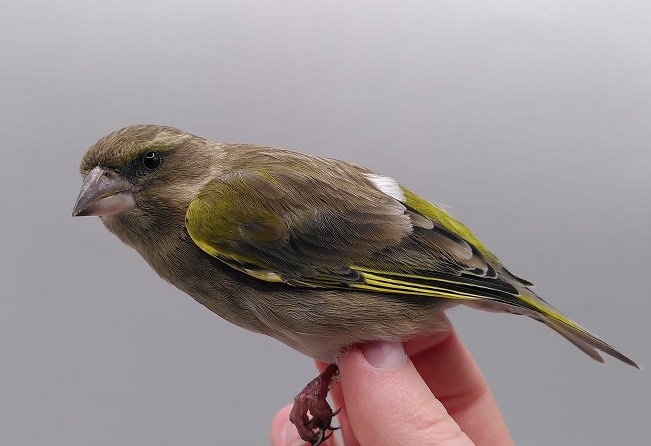
A 1st Calander year female Greenfinch (Grønirisk) from today's ringing too by Mara.
We came back and had some nice lunch. Ragnar left for Aalborg for an afternoon/evening enjoying himself and Mara was having fun in the garden ringing. The session was super quiet with only two birds, but it was quality and not quantity. A late, possibly overwintering, Blackcap (Munk) and a new Greenfinch (Grønirisk) was the best of the bunch.
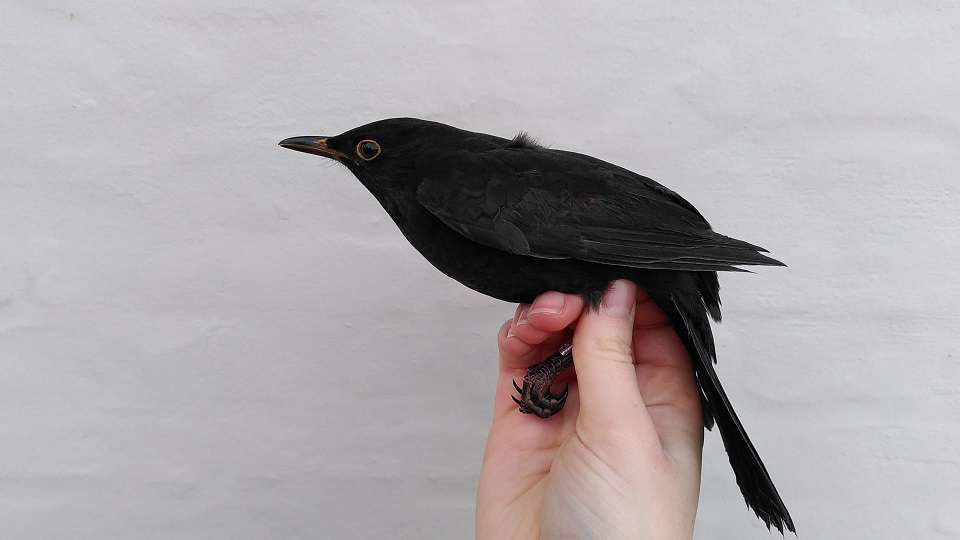
A 1st Calander year male Blackbird (Solsort) from today's Lighthouse garden ringing by Mara.
Plus, a couple of retrap Blackbird (Solsort) which are always lovely birds, especially in their charcoal colours. Mara left the nets open until the evening before having a chilled one.
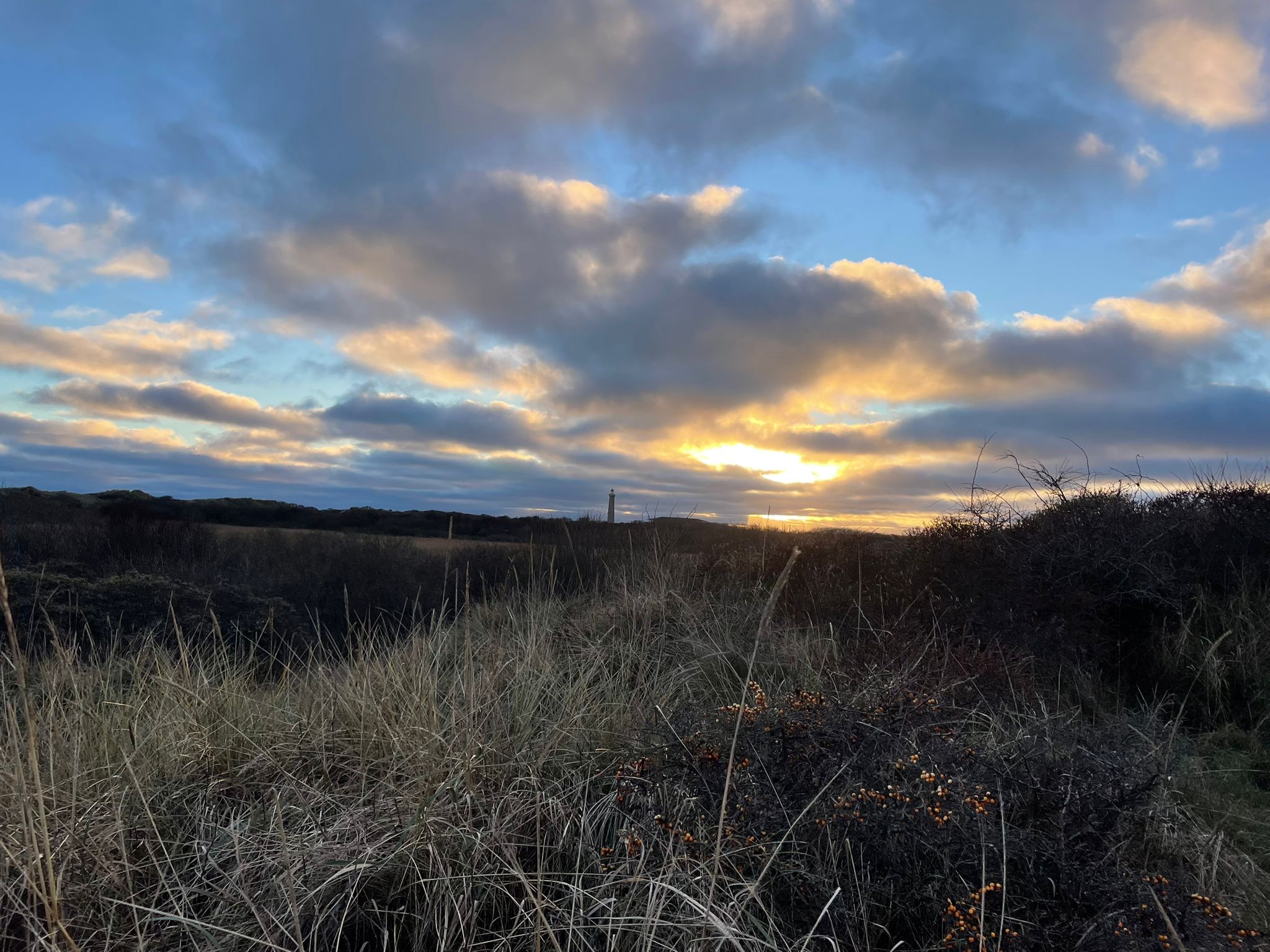
Kabeltromlen's reedbed view by Eleanor.
Eleanor and I went for a nice cycle around the area. We stopped off at Kabeltromlen where there were a few Goldcrest (Fuglekonge) and some nice open skies. Nice to be back here after not ringing here for over a week.
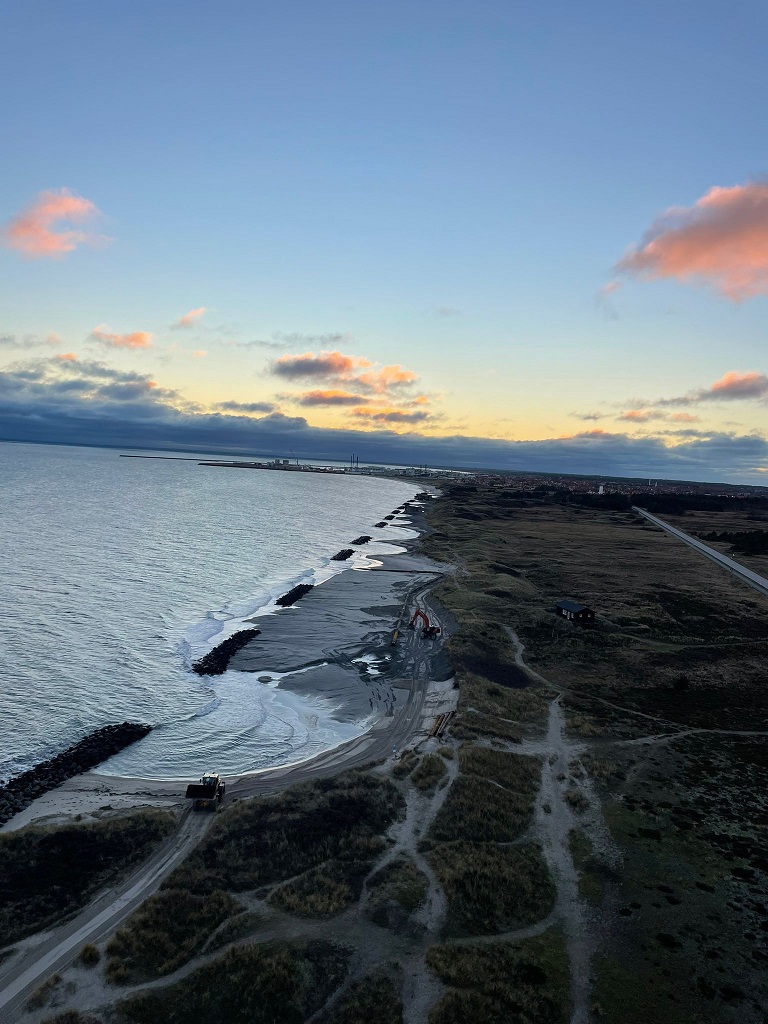
An autumnal sunset from Det Grå Fyr by Eleanor.
We went through Elle Krattet and onto the heathlands in search of any nice wildlife before making our way up the lighthouse for a sunset. Species seen from the top included some Sanderling (Sandløber), a few Eiders (Ederfugl) and a small flock of Herring Gulls (Sølmåge).
A very quiet evening for all this evening with just the trio in the obs.
Highlights from the observatory:
- Two 1st calendar year Glaucous Gulls (Gråmåge)
- Sooty Shearwater (Sodfarvet Skråpe)
- Little Auk (Søkonge)
- Late Blackcap (Munk)
Ringing totals
Det Grå Fyr
|
Greenfinch |
Grønirisk |
1 |
|
Blackcap |
Munk |
1 |
Overall total: 2
Today’s observations on Dofbasen from observers in the area
People: Thomas Weston, Eleanor Harris, Emma Fabre, Mara Glane, Ragnar Smith, Simon Sigaard Christiansen & Eric Christophersen.
Kittiwake (Ride) day
This morning I went to the obs with Ragnar and Knud. We had some sun and not so much wind. The birds were present. In the first hour, we had a continuous stream of Kittiwake (Ride). In the next hour the stream was replaced by many smaller flocks, coming close to the shore. A few Kittiwakes (Ride) even flew over us. In total we had 1987 individuals.
Kittiwakes (Ride) 1k
Migration obs was also good for the other birds, some flocks of Common Scoters (Sortland), Auks (Lomvies and Alk), Red-throated Divers (Rødstrubet Lom) and Gannets (Sule). We also saw some nice species. In the firsts hours, a 1k Glaucous Gull (Gråmåge) was flying northwest, then a few minutes after we saw him resting with the other Gulls on the beach. Then we spotted a Great Skua (Storkjove), a little bit far away. We saw two Little Auks (Søkonge) 3 Fulmar (Mallemuk) and one Black-throated Diver (Sortsturbet Lom). In the resting Gulls flock, we spotted 4-5 Caspian Gull (Kaspisk Måge).
Glaucous Gull (Gråmåge) 1k
Thomas and Eleanor undertook the Fulmar (Mallemuk) survey. They walk to the lighthouse along the beach. They noted the dead birds and collected the fresh dead birds. They didn’t find a Fulmar (Mallemuk) but they found some dead animals: 2 Common Scoter (Sortland), a Porpoise…. 2 Woodcock (Skovskeppe), a Wigeon (Piband). They collected a not so long dead Kittiwake (Ride). They also found a lost dinosaur :
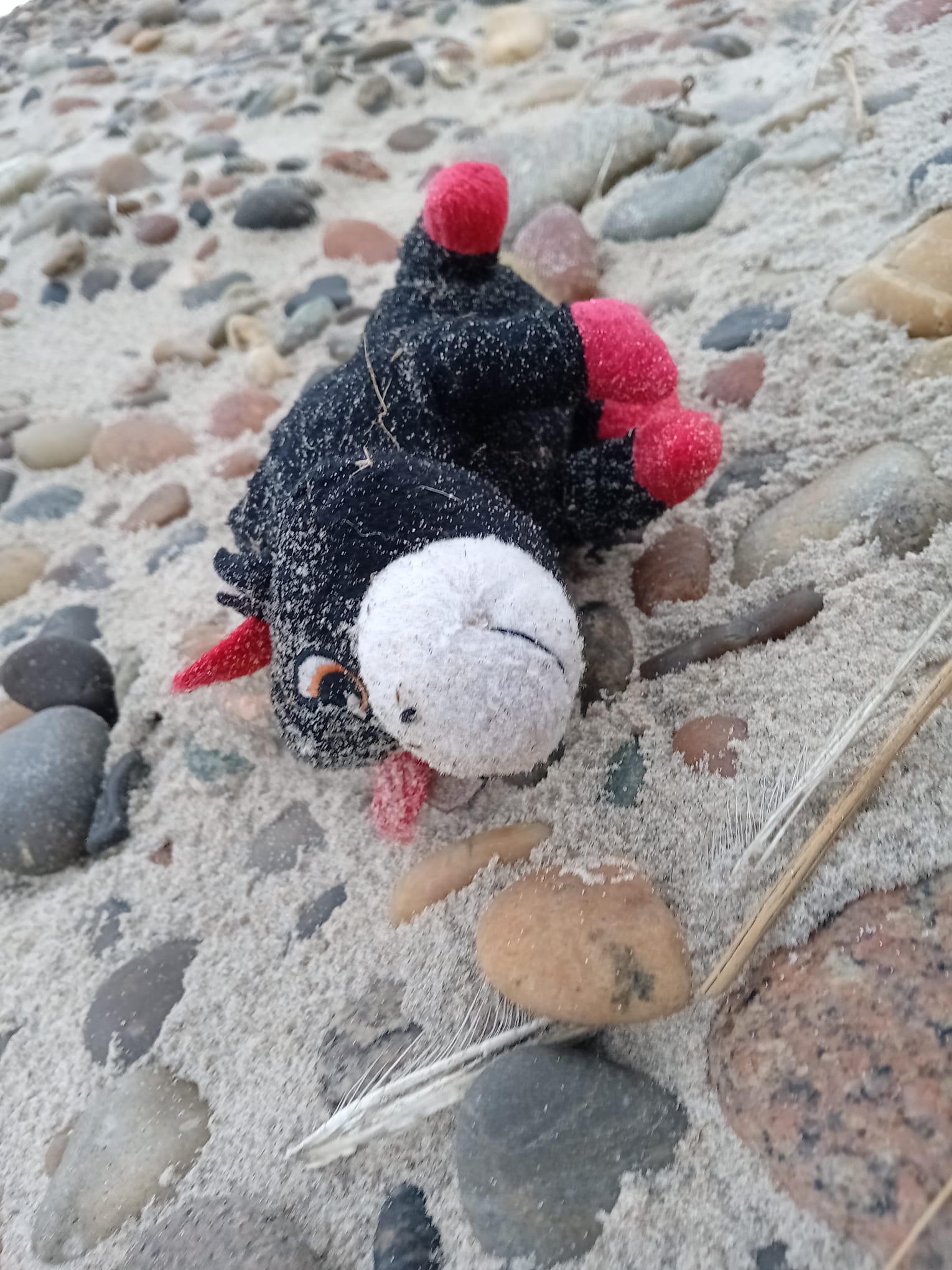
Dinosaur
Still in the morning, Mara opened the nets of the lighthouse garden. They stayed open all the day. She caught 7 birds. She ringed 3 Blackbirds (Solsort), one Redpol (Gråsisken) and one Greenfinch (Grønirisk).

Redpol (Gråsisken)
In the evening we played at Wingspan, Mara won and Ragnar… lost, I arrived second with my swan killer and Thomas and Eleanor arrived third.
Ringing (Grey lighthouse):
Brant/Gærdesmutte – 1
Blackbird/Solsort - 3 Redpol /Gråsisken-1 Greenfinch (Grønirisk) - 1 Great Tit/ Musvit -1
Total:7
Highlights from observations:
Little Auk/ Søkonge – 2
Kittiwake/Ride - 1987
Glaucous Gull /Gråmåge– 1k
Great Skua /Storkjove - 1
Link to today's observations from observers in the area
People at the station: Thomas Weston, Emma Fabre, Mara Glane, Ragnar Smith, Simon Sigaard Christiansen, Eleanor Harris, Knud Pedersen
Back at it again
Today we finally could do migration count as the rain had stopped/quieted down, though the wind was blowing quite strong from SW, but wind usually equals birds so me, Mara and Emma went to Worlds End 3, while Thomas and Eleanor went out to look for Water Pipits (Bjergpiber). The migration count was quite a success! Even though the very light rain really messed with the conditions and made it somewhat hard to see the birds that were further out (It is possible to find and ID birds at 4-5 km distance under acceptable conditions), we still managed to see loads of kittiwakes (Ride), alcids (Alkefugl) and divers (Lommer) migrating SE and among the specialties we had Caspian Gulls (Kaspisk Måge), a very nice Great Skua (Storkjove) that came by close towards SE, same did a Sooty Shearwater (Sodfarvet Skråpe), but the observation-conditions really hampered the views on a Great Northern Diver (Islom) that went southeast and made it impossible to ID three big divers that went same direction, but they were probably Great Northern Divers too.
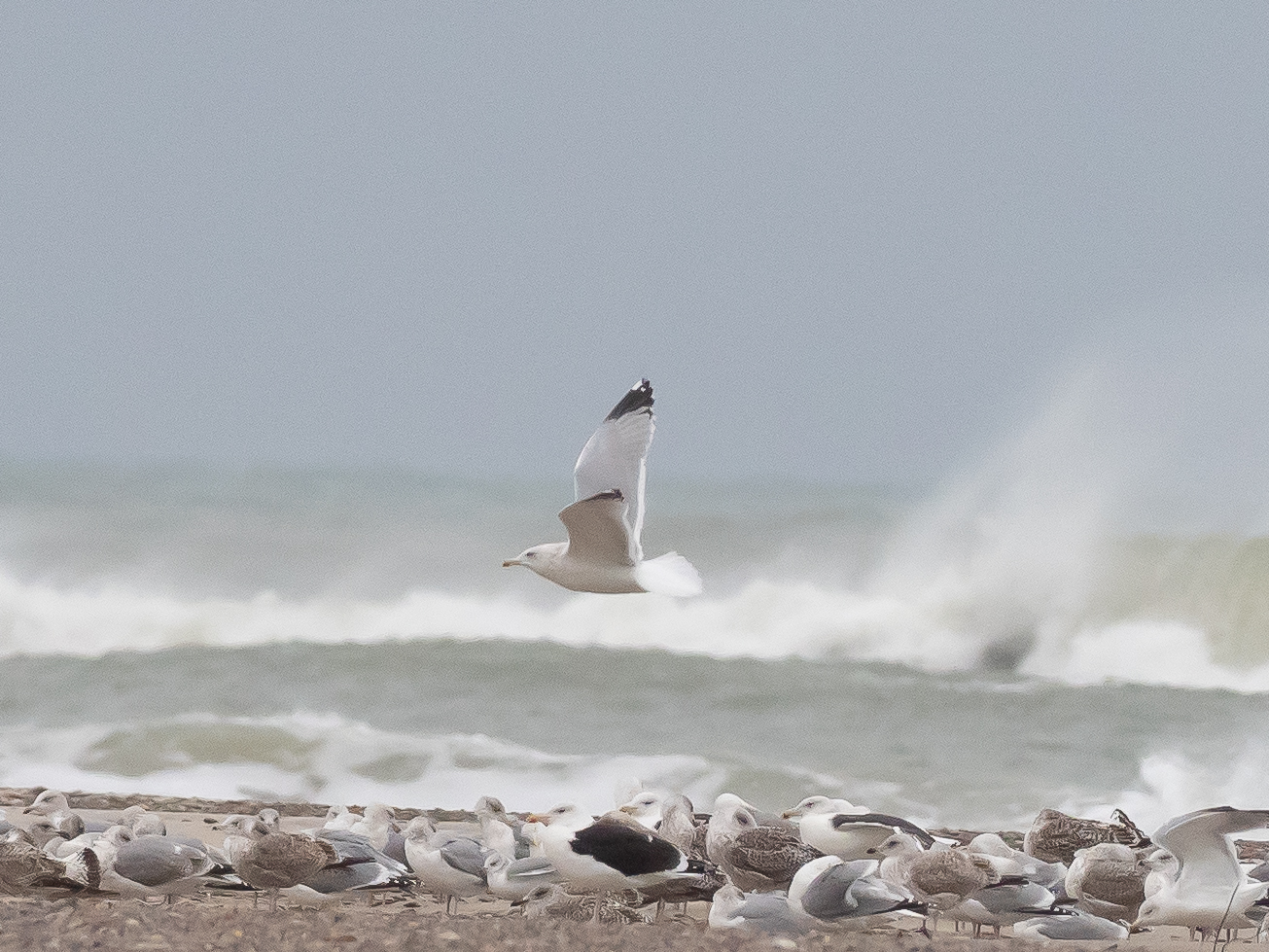 Atleast the gulls were close - a Herring Gull with extensive black in the primaries, looking rare
Atleast the gulls were close - a Herring Gull with extensive black in the primaries, looking rare
But even with a nice, warm morning/day like today, one bird left a somewhat bitter taste in my mouth, as I picked up a large shearwater that went southeast and a few hours later went northwest. Big, brown with white underparts, off-white underwings and slightly backswept primaries and flight style pointed towards Great Shearwater (Storskråpe), but it was far away and the conditions did not permit to nail down the ID for this very rare shearwater species! It would have been 11th record for Denmark and the first record for Skagen since 1982 of this quite exclusive shearwater, and it would have been the cherry on the top for an astounding seabird season for Skagen, as it would have been the fifth(!) shearwater-species recorded in Skagen this autumn with Manx Shearwater (Almindelig Skråpe), Sooty Shearwater, Balearic Shearwater (Balerisk Shearwater) and Cory’s Shearwater (Kuhl’s Skråpe) being the other ones. But maybe we will see another one tomorrow as the wind slows down tomorrow, fingers crossed. After this successful obs we went back to the station, where Simon still was busy with a board meeting. I took a long nap as Thomas and Eleanor came back, though they hadn’t found any Water Pipits, they found Crested Tit (Topmejse) and Treecreeper (Træløber) during their long walk along Jennes Sø, Batterivej and North Beach.
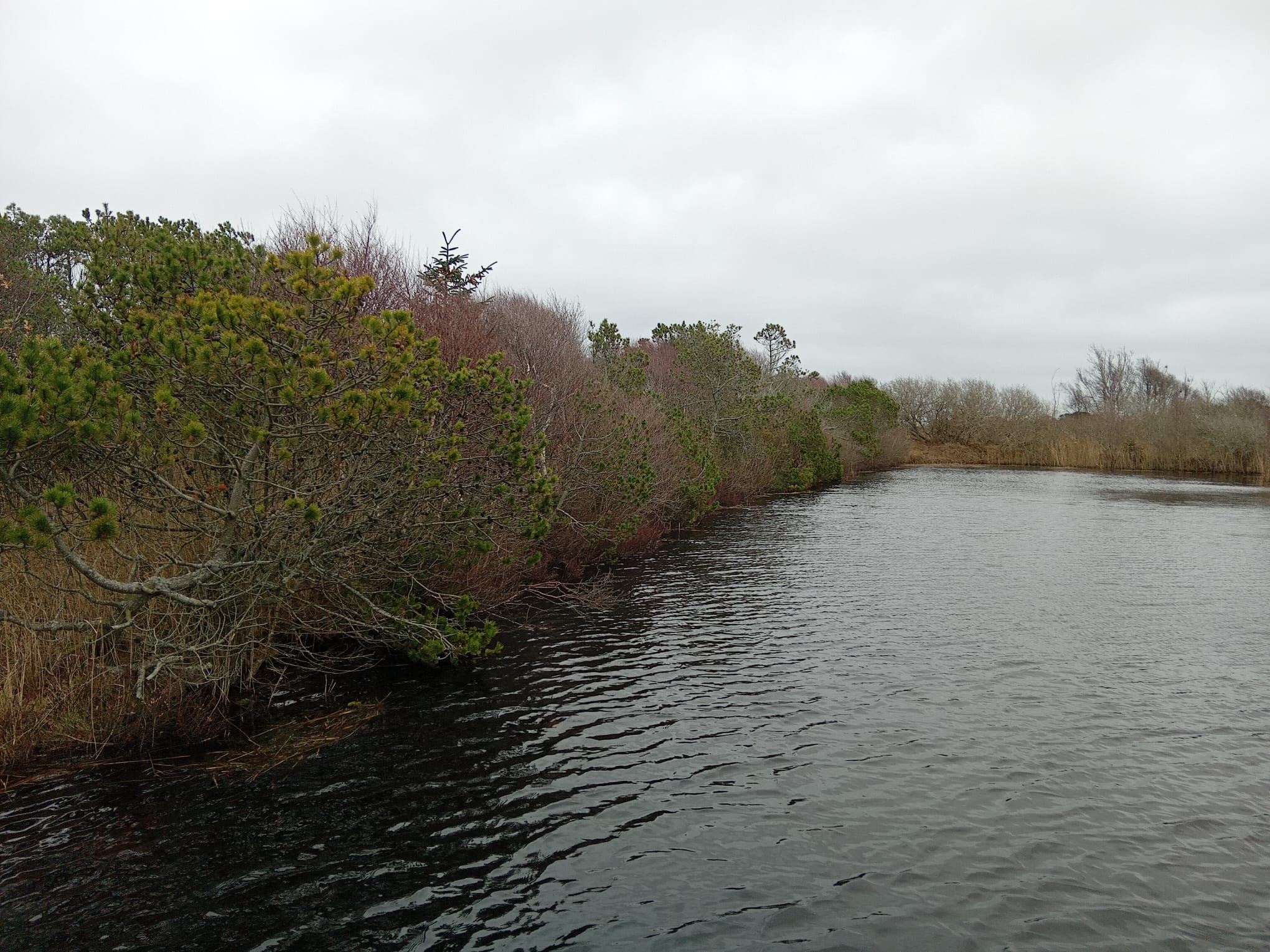 Jennes Sø without ice, a great spot for passerines
Jennes Sø without ice, a great spot for passerines
The rain set in and now we have had a cozy evening, though we got a mail from the Russian ringing center concerning two Herring Gulls (Sølvmåge) we had read the rings of. Both were ringed near Murmansk in northeastern Russia and one of them was in ringed in 2007 on the nest! 17 years old and still going, which is crazy. The other one was ringed in 2008 at the same spot, “only” 6 years old. Just proves why ringing is such a useful tool that will keep on giving new and interesting nuggets of knowledge about the life of birds
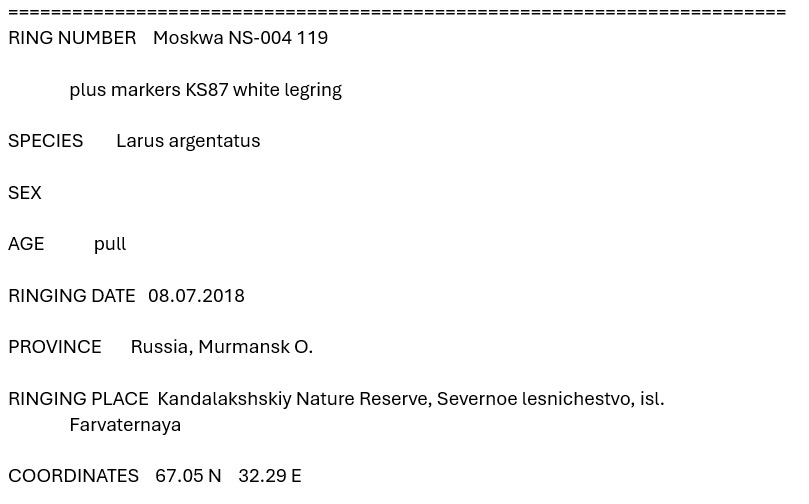 Answer-letter from russian ringing central concerning or 17 year old Herring Gull!
Answer-letter from russian ringing central concerning or 17 year old Herring Gull!
Highlights from obs:
Sooty Shearwater – Sodfarvet Skråpe 1, it is getting late, but somewhat expected with this exceptional autumn season for this trans-atlantic migrant
Great Skua - Storkjove 1
Caspian Gull – Kaspisk Måge 3
Great Northern Diver – Islom 1
Link to today's observations from observers in the area
People at the station: Thomas Weston, Emma Fabre, Mara Glane, Ragnar Smith, Simon Sigaard Christiansen, Eleanor Harris.
A rainy day
Today was a chill day. The rain prevented us from doing any field tasks in the morning. We woke up later, enjoying some extra sleep.
Thomas went to Aalborg to meet Eleanor, his girlfriend. When he was leaving, he saw a pipit fling into the dunes. So Ragnar, came out to see what is it. It was a Water Pipit (Bjergpiber). We might try to catch it in the next days. Thomas and Eleanor returned to the station in the evening. In the afternoon, the rain stopped, allowing us to go outside. We went to check the gulls at World’s end III. Ragnar and Mara saw some Mistle Thrushes (Misteldrossel) along the way. There were many pools on the beach, with some Black-heded Gulls (Hættemåge) feeding in them. Some Sanderlings (Sandløber) and Snow Buntings (Snespurv) were moving around the pools.
In the afternoon, the rain stopped, allowing us to go outside. We went to check the gulls at World’s end III. Ragnar and Mara saw some Mistle Thrushes (Misteldrossel) along the way. There were many pools on the beach, with some Black-heded Gulls (Hættemåge) feeding in them. Some Sanderlings (Sandløber) and Snow Buntings (Snespurv) were moving around the pools.
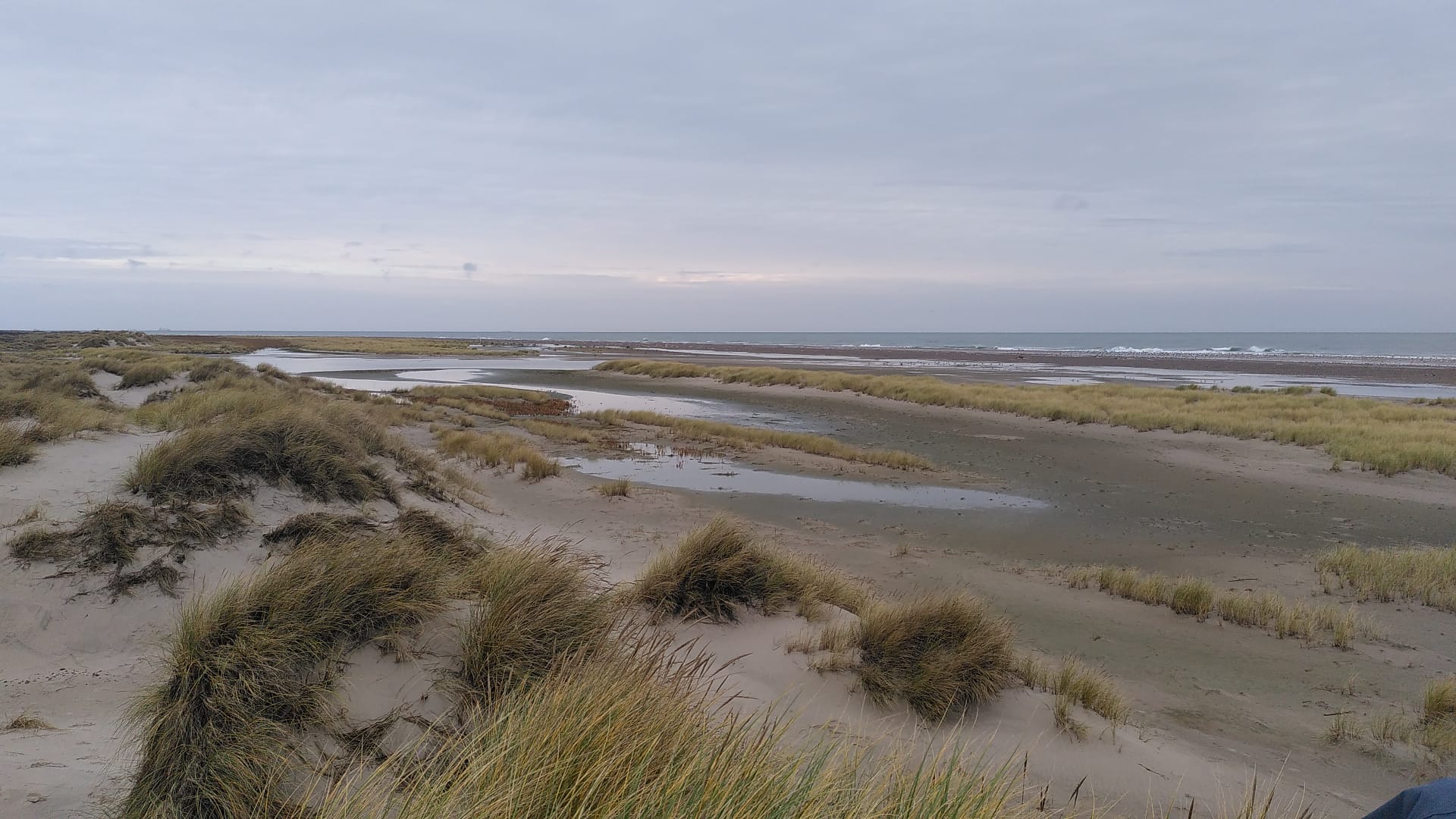
Hundreds of gulls were resting close to the shore and in the pool. The flock was mostly constisted of Herring Gulls (Sølvmåge), Great Black-backed Gulls (Svartbag), Common Gulls (Stormmåge) and Black-headed Gulls (Hættemåge). We scanned the flock, hoping to find some rare gulls. We only saw five Caspian Gulls (Kaspisk Måge). Ragnar found a Viking Gull, it is a hybrid between a Glaucous Gull (Gråmåge) and a Herring Gull (Sølvmåge). We didn’t see any Iceland (Hvidvinget Måge) or Glaucous Gulls (Gråmåge), which was a little bit disappointing.
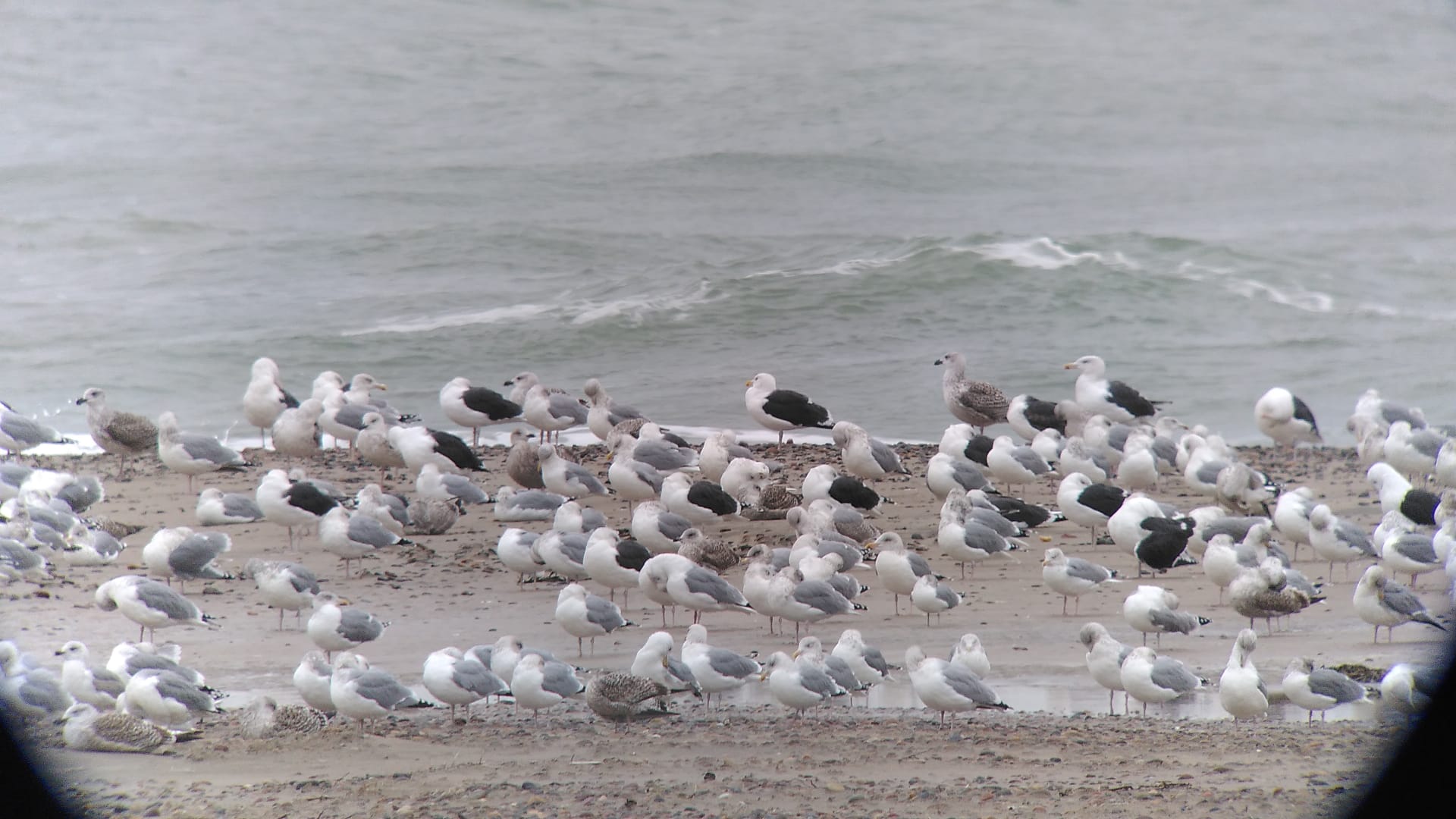
I walked to the lighthouse and continued my walk to the south before returning to the light house when the sun went down.
Highlights from observations:
Caspian Gulls (Kaspisk Måge)- 5
Viking Gull - 1
No ringing today due to the weather.
Link to today's observations from observers in the area
People at the station: Thomas Weston, Emma Fabre, Mara Glane, Ragnar Smith, Simon Sigaard Christiansen, Eleanor Harris.
Canned Croissants
The day started with everyone having a lie in this morning after a night of playing Wingspan late into the night and the weather being extremely wet and windy resulting in a day of no ringing or migration.
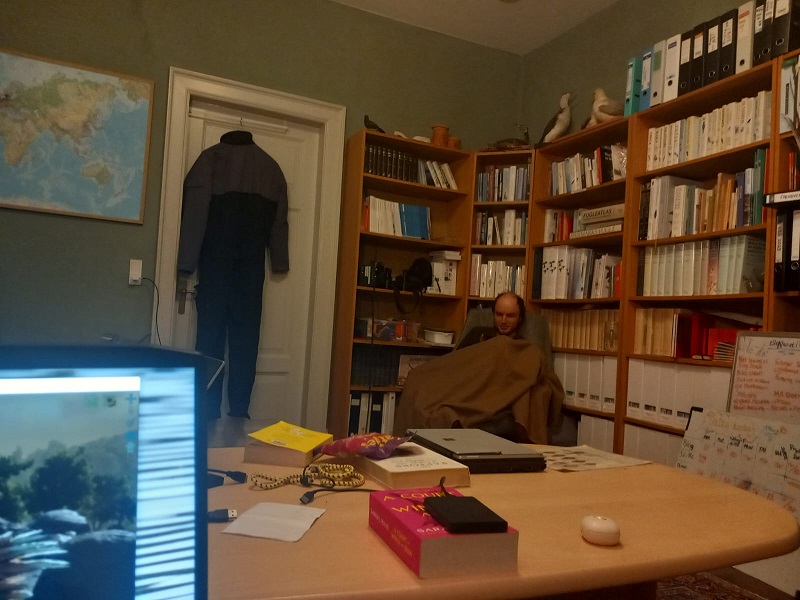
This photo pretty much sums up today, wet and windy out so an inside day.
I ended up having a nice breakfast, which included one of Mara’s Canned Croissants – more to come so keep reading. I then inputted some of our nocturnal migration data onto Trektellen. In the two nights we had some great surprises back in October including Redwing (Vindrossel), Blackbirds (Solsort) and even an Olive backed Pipit (Taigapiber) picked up by Emma in the recordings. Our findings for those two days can be found here with the nocturnal counts from that week found on Trektellen too. https://www.trektellen.org/count/view/2601/20241018 & https://www.trektellen.org/count/view/2601/20241019. I then spent the rest of the day counting the ring stock and identifying any missing rings resulting in 28,000+ rings counted. Now to see if it matches up to the ringing data on the database!
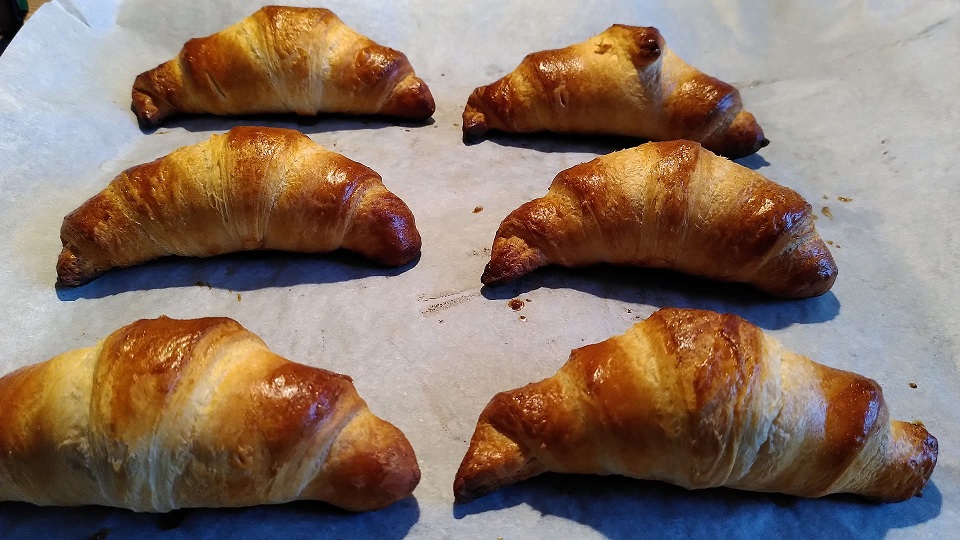
The result of Canned Croissants...
For the others, Mara started her day making her canned Croissants, which sound rather weird, but are basically pastry in a can and once rolled and then baked do taste of Croissants. Who would have thought? They may or may not have had the French approval from Emma, I will have to ask for a full review. I found them nice though!
Mara also looked through our ringing data from this year and it’s a bit of a sad outlook for our passerines and big declines over the last five years for most species. More of this to come in a future blog post and on our social media channels. She helped Simon with some of our recapture sheets and our data checking is almost complete with only a few more data bits to check before the end of season.
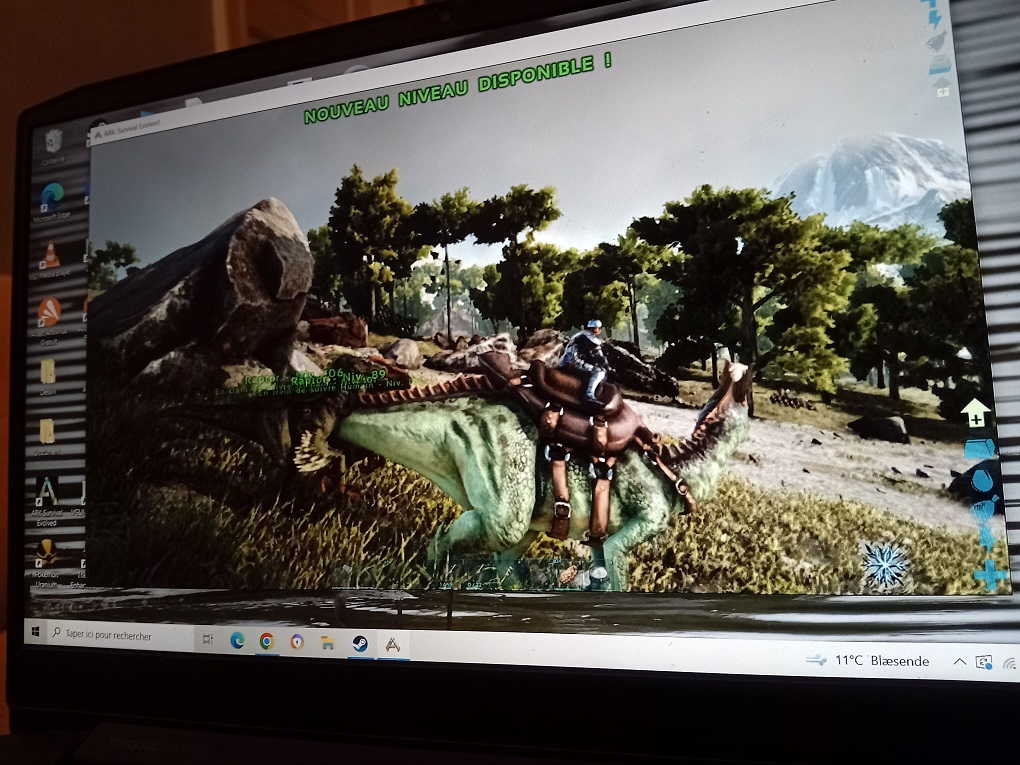
The only dinosaurs Emma saw today.
Meanwhile, Emma had a very chilled day and spent the morning uploading pictures into the archive and enjoying some gaming in the afternoon making the most of the wet and windy inside day. Ragnar spent the morning writing the blog, had a very quick look outside to try find some birds, without success, and then came back, chilled and cooked a very lovely meal this evening. Simon turned up this evening for evening meeting.
It is looking like another wet one tomorrow so we shall see what happens…
Highlights from the observatory:
- 25 Herring Gulls (Sølvmåge) from the observatory
Ringing totals
Too wet and wind today.
Overall total: 0
Today’s observations on Dofbasen from observers in the area
People: Thomas Weston, Emma Fabre, Mara Glane. Ragnar Smith, Simon Sigaard Christiansen.
SKAF big day out
Saturday was field trip day! “Early” in the morning at 0640, Simon picked us up at the observatory and then we went south. Our goal was to go to Lille Vildmose to see Smew (Lille Skallesluger), Bean Goose (Sædgås), Golden Eagle (Kongeørn), then try for the King Eider (Kongeederfugl) at Egense and then try for the Steppe Eagle (Steppeørn) near Sæby. But what about the morning obs? Thankfully Knud said yes to cover for us, so we could go and thank you so much for that Knud, you are a champion! But off we went towards Lille Vildmose and after aprox one hour we arrived, but everything was frozen over and covered in snow, which is suboptimal conditions for waterfowl such as smew. Lillesø had no birds, except some Bearded Tits (Skægmejse) and Toftesø had a sad looking Whooper Swan (Sangsvane), tracks from an Otter (Odder) and a flyby Green Woodpecker (Grønspætte), but in the eternal words of the legendary urban poet Vanilla Ice “Ice, ice, baby” and therefore no smews or any other ducks. We went over to some fields were Lisa was trying to catch Tajga Bean Geese (Tajgasædgås) to say hello and look at geese.
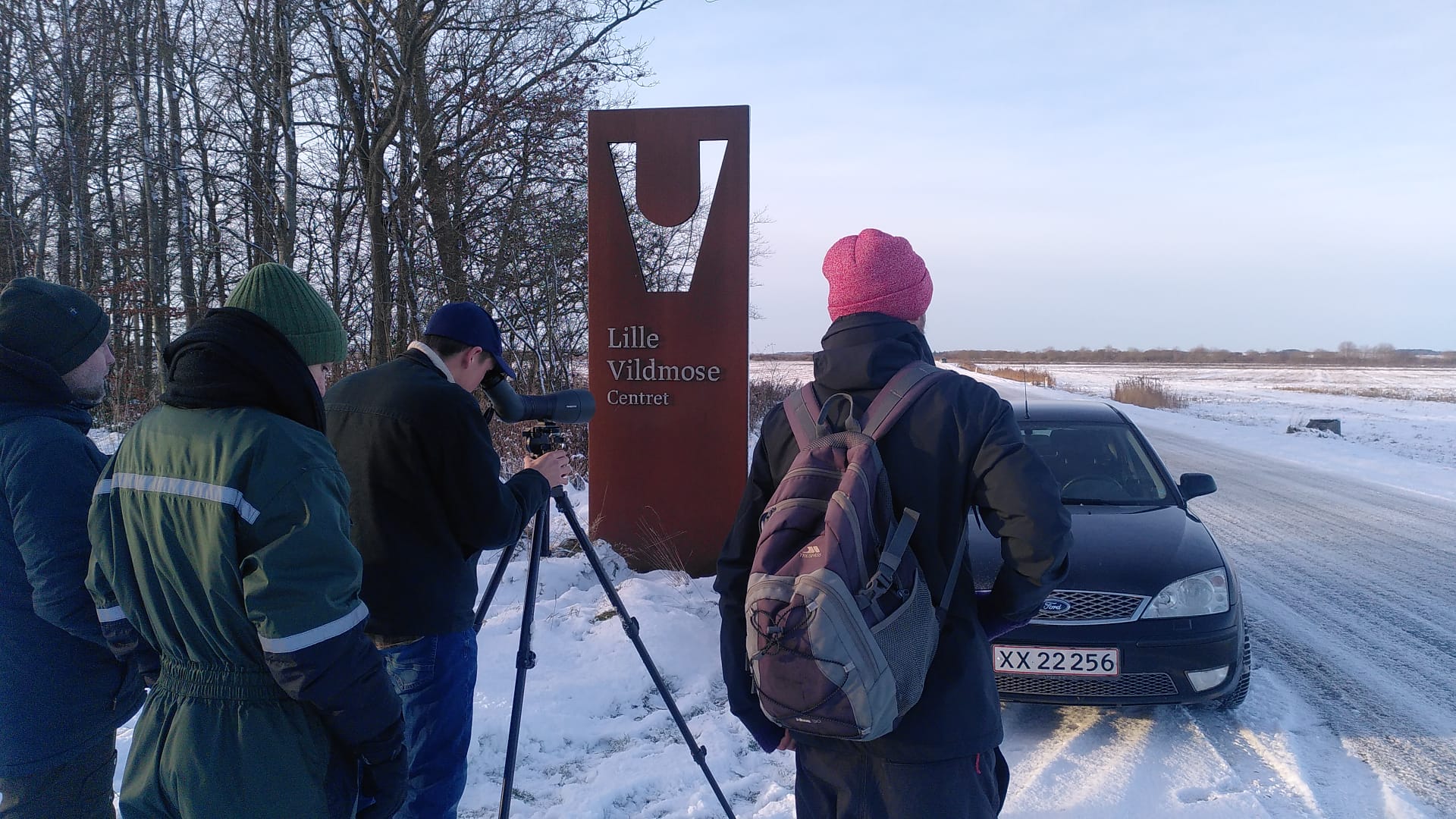 Proof of us being in Lille Vildmose, thanks to Lisa for holding unto the beans so we could see them
Proof of us being in Lille Vildmose, thanks to Lisa for holding unto the beans so we could see them
It was nice to see them again as they are quite local, and you need to know where to find them. Among all the beanies were Greater White-fronted Geese (Blisgås), Barnacle Goose (Bramgås) and Pink-footed Geese (Kortnæbbet Gås).
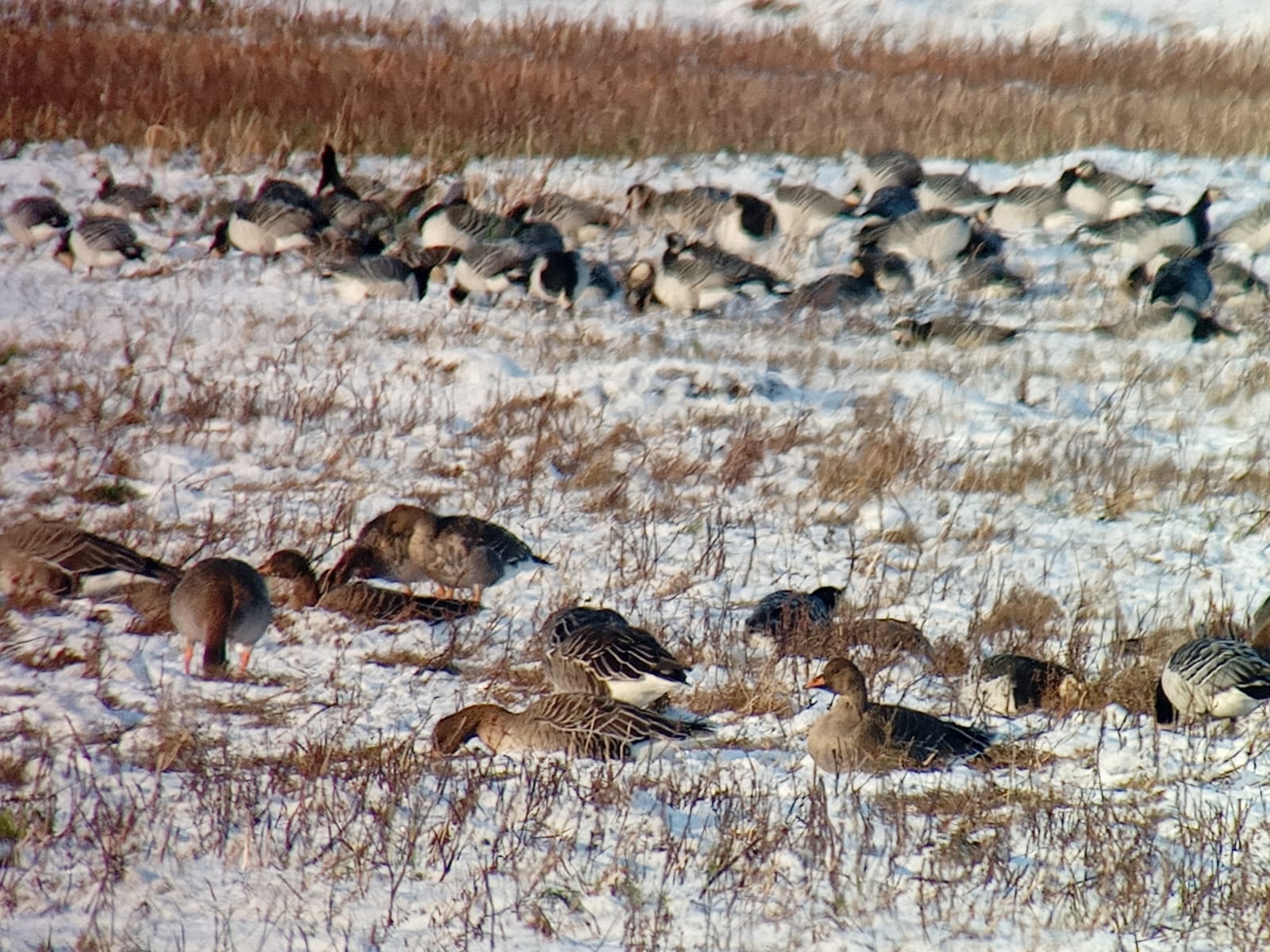 A bunch of beanies and barnacles
A bunch of beanies and barnacles
After some deliberation we went out to look for the Golden Eagles in the area, lo and behold a nice 2k from last year was perched on a pool like a dark sack of potatoes, but only for a short time before it took off. We kept driving and refound it in a tree where it was mobbed by a Rough-legged Buzzard (Fjeldvåge)!
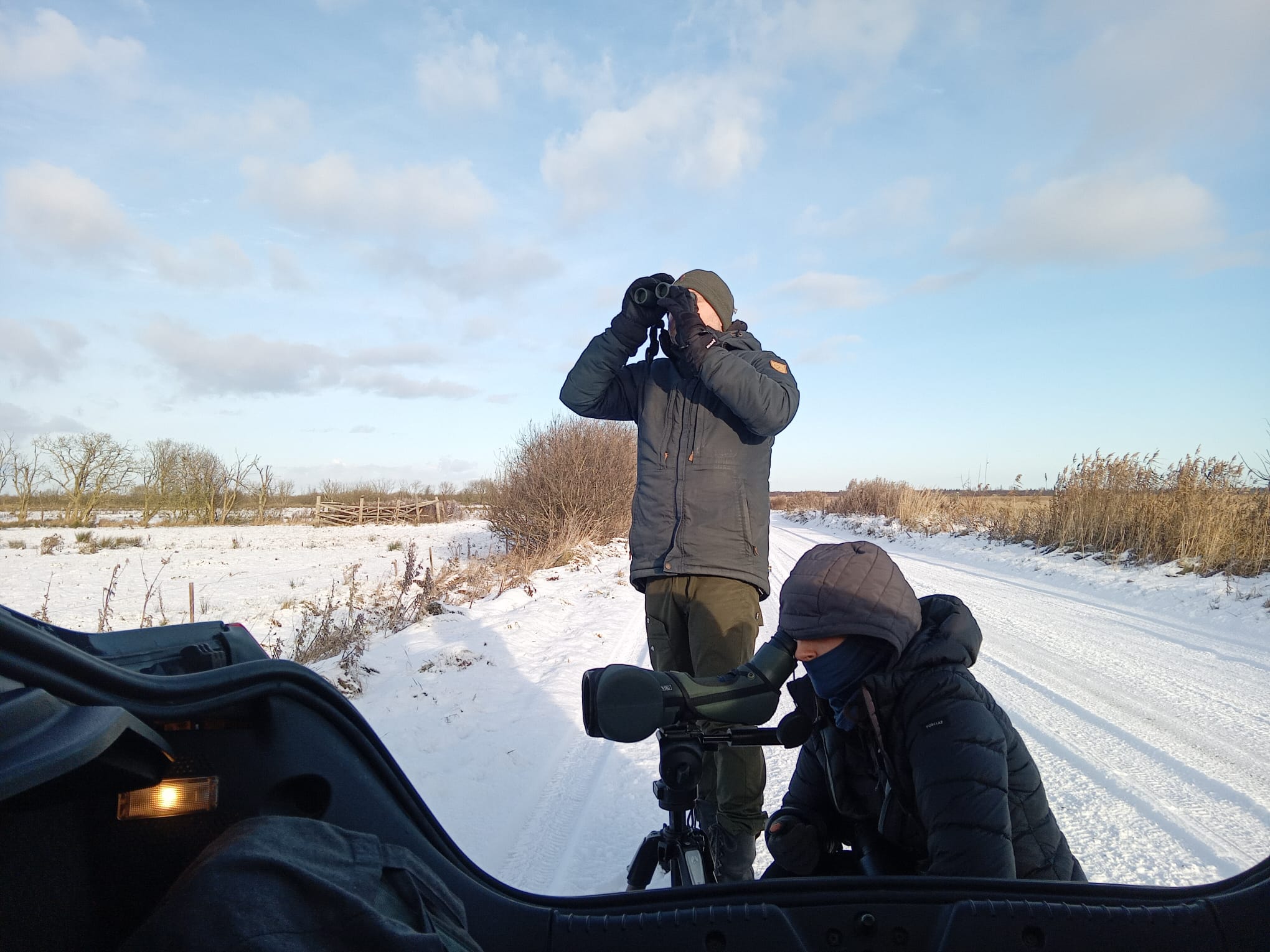 Simon and Emma looking at the eagle
Simon and Emma looking at the eagle
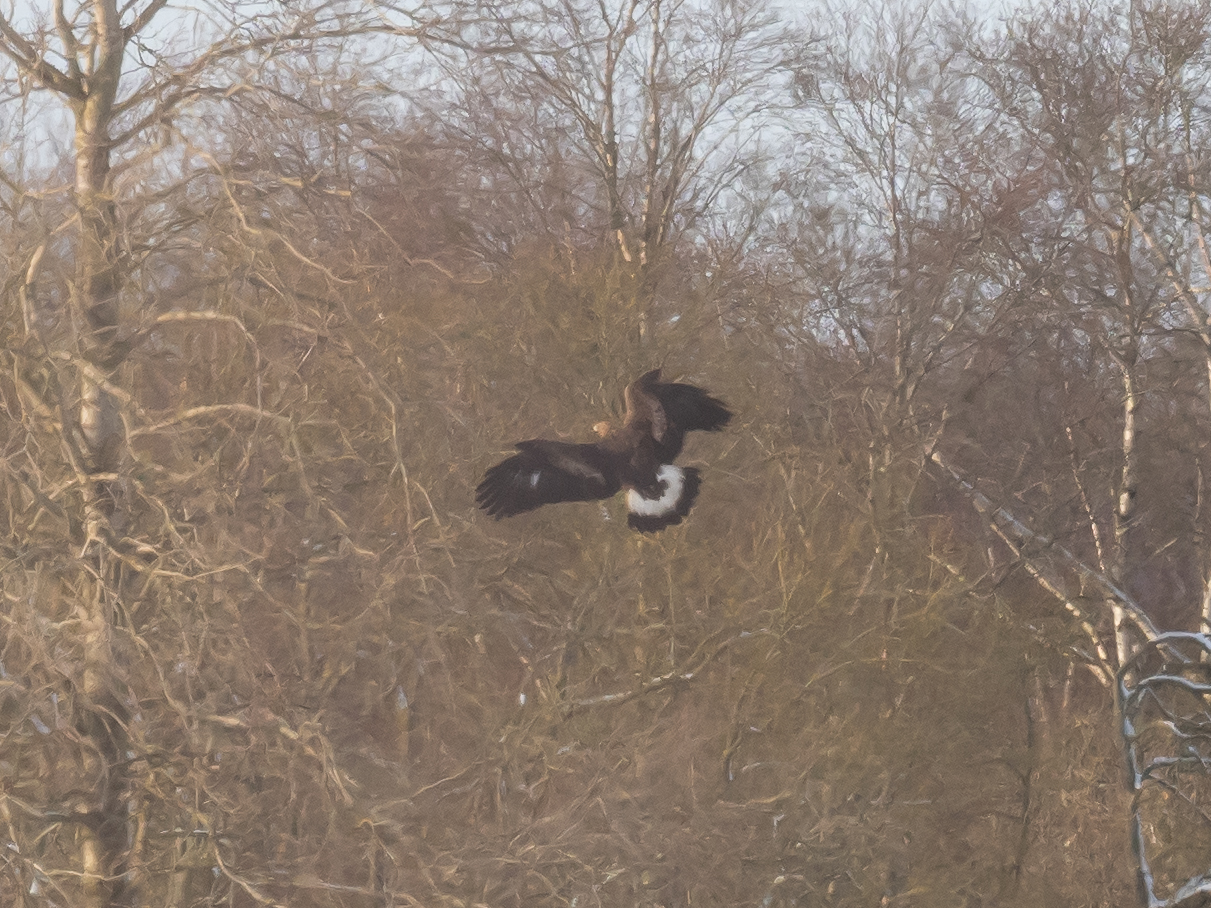 Golden Eagle 2k
Golden Eagle 2k
We put up the scopes and got some nice views of one of the better-looking eagles. We kept driving and got very nice views of a male Hen Harrier (Blå Kærhøg) that went over the car, a hunting female-plumaged hen harrier and a nice adult White-tailed Eagle (Havørn). We then turned around and headed towards Egense, were we hoped to smew and the king eider. After a short drive we arrived and very quickly we noticed a disturbing absence of smews but there were loads of eiders far out on the sea. So the scopes were put up and we are started going through the all eiders. I managed to see the King Eider for a very short time! But we never refound it again, though there were plenty of Pale-bellied Brents (Lysbuget Knortegås), Greater Scaups (Bjergand), Redshanks (Rødben), Shelducks (Gravand) and other birds. We spent the remainder of time, aprox one hour going back and forth in the huge gaggle of eider trying to look for a smaller, darker eider, but no dice. I went back to the car to talk with Simon and on the way back to inform the others that we probably should leave I heard the call of a kingfisher (Isfugl) and saw two kingfishers fly onto a rock and then land near were the others were standing! I ran back to the car to grab the camera and then ran towards the others and saw the kingfisher fly off again. I told the others and then I flushed the second one, which everyone saw.
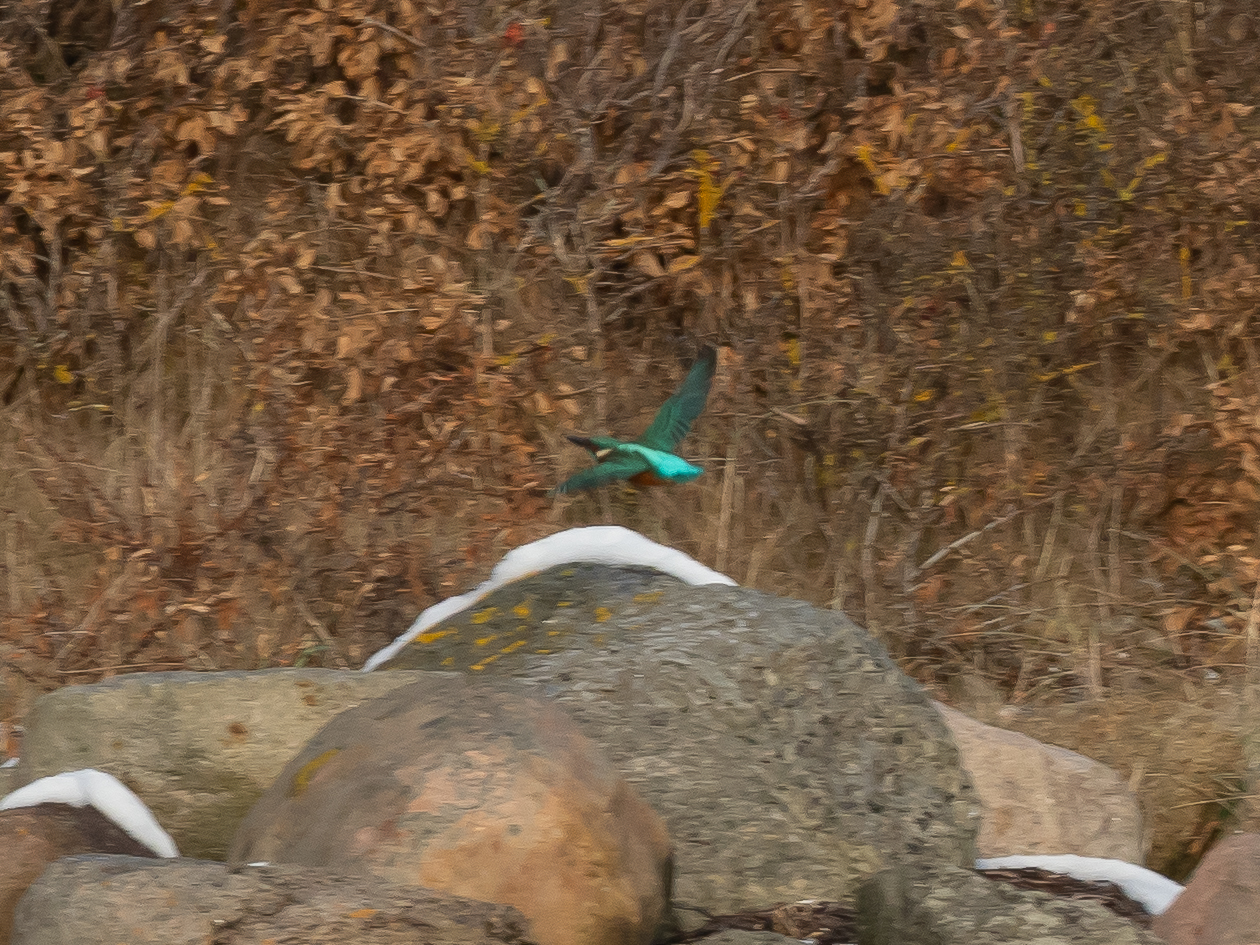 The blue lightning
The blue lightning
A nice bird but a poor substitute for a King Eider in my opinion. We then went north towards the Steppe Eagle and on our way we saw a large flock of geese and swans, where Thomas saw what looked like Bewick’s Swan (Pibesvane). Simon whipped the car around and we parked so we could look for it again. We couldn’t find any Bewick’s Swan but found a Canada Goose X Barnacle Goose (Canadagås X Bramgås), a hybrid and some Greylag Goose X Canada Goose hybrids among all the Canada geese.
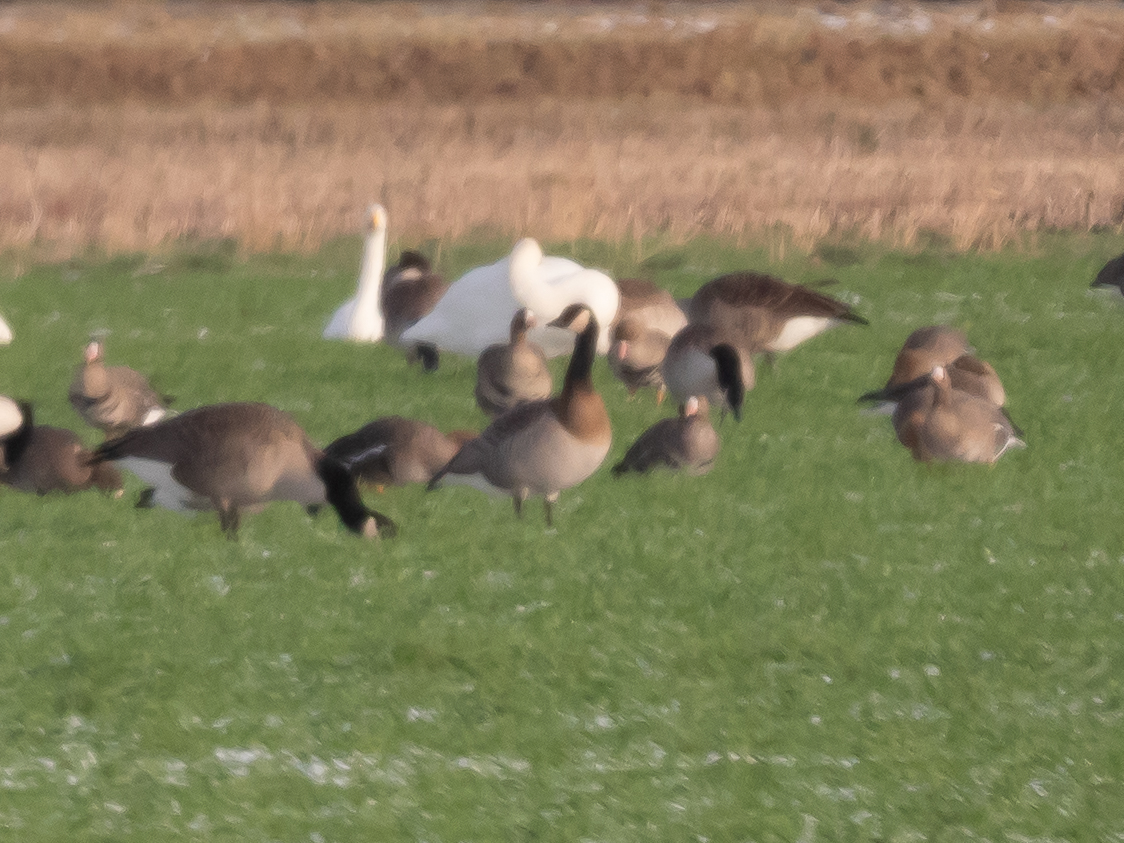 Canada Geese will hybridise with anything - Canada Goose X Barnacle aka Canacle Goose aka Barnada Goose.
Canada Geese will hybridise with anything - Canada Goose X Barnacle aka Canacle Goose aka Barnada Goose.
After that short stop at Føtex in Aalborg to resupply we were in Steppe Eagle country southwest of Sæby. Slowly we drove through the Till landscape, a leftover from when glaciers during the ice age were covering Denmark and created a hilly landscape as they deposited sendiments all over the country during their retreat in the post-ice age periods. After some driving around, Thomas spotted another sack of potatoes perched on a coniferous tree, this time a Steppe Eagle! It was sitting very nicely and we all enjoyed awesome views of this quintessential Aquila-eagle. Even though I have seen 56.000 of this central Asian eagle-species, I will never be tired of seeing it and everyone else than me and Simon also got a new tick!
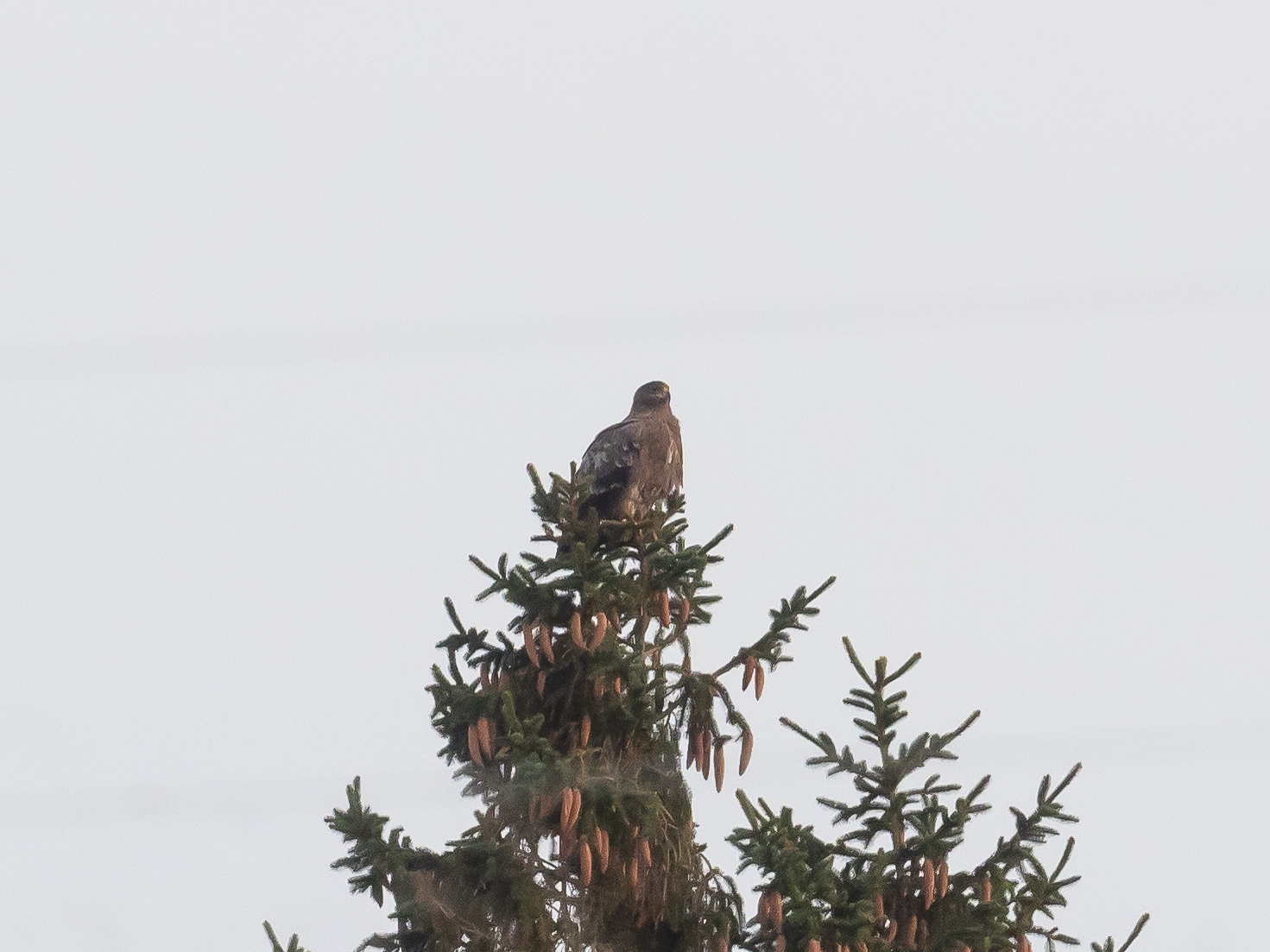 Steppe Eagle, it arrived to Denmark in spring 2023 as a 2k and has spent 18 months in Denmark and will probably stay the winter in Skagen again, instead of Ethiopia
Steppe Eagle, it arrived to Denmark in spring 2023 as a 2k and has spent 18 months in Denmark and will probably stay the winter in Skagen again, instead of Ethiopia
We got the Steppe Eagle, now what? We decided to head north as the sun was slowly setting and first stop at Bangsbo Botanical Garden and then go to Strandby. Bangsbo is a good place to see Tawny Owl (Natugle), Dipper (Vandstær) and other forest-species. But we didn’t see any of them, but instead we saw a Marsh Tit (Sumpemejse) and Nuthatch (Spætmejse), both rarities in Skagen, with Marsh Tit only recorded once or twice ever in Skagen, it is as rare as Marmora’s Warbler (Sardinsk Sanger) in Skagen. We drove north and as we reached Strandby Harbour I spotted the greatest thing I have ever laid my eyes upon: a giant metal statue of a shrimp. I felt like a pilgrim who was seeing the holiest of holy relicts for the first time ever and I made Simon pull the car to the side so I could get a photo with it, it was shrimply too good an opportunity to pass up on. Truly the best thing we saw on this trip in my opinion.
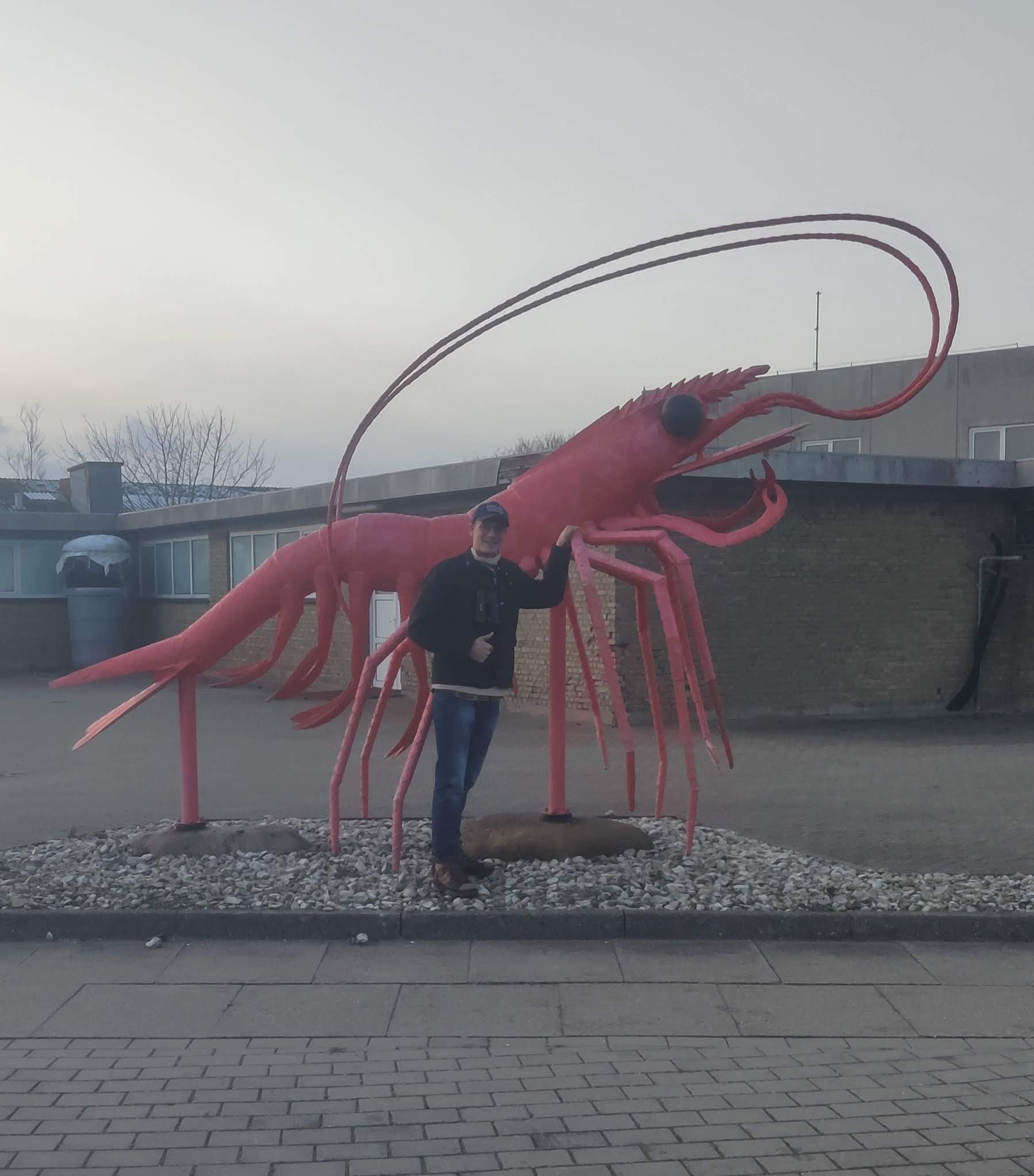 A must-see for everyone visiting the Skagen Peninsula, it rivals the Little Mermaid in Copenhagen in beauty and cultural significance
A must-see for everyone visiting the Skagen Peninsula, it rivals the Little Mermaid in Copenhagen in beauty and cultural significance
We then headed to a large tower that was overlooking the entire harbour and we managed to pick up a Black Guillemot (Tejst) and a Common Guillemot (Lomvie). Also, we saw some of the largest gulls we had ever seen, the pictures speak for themselves.
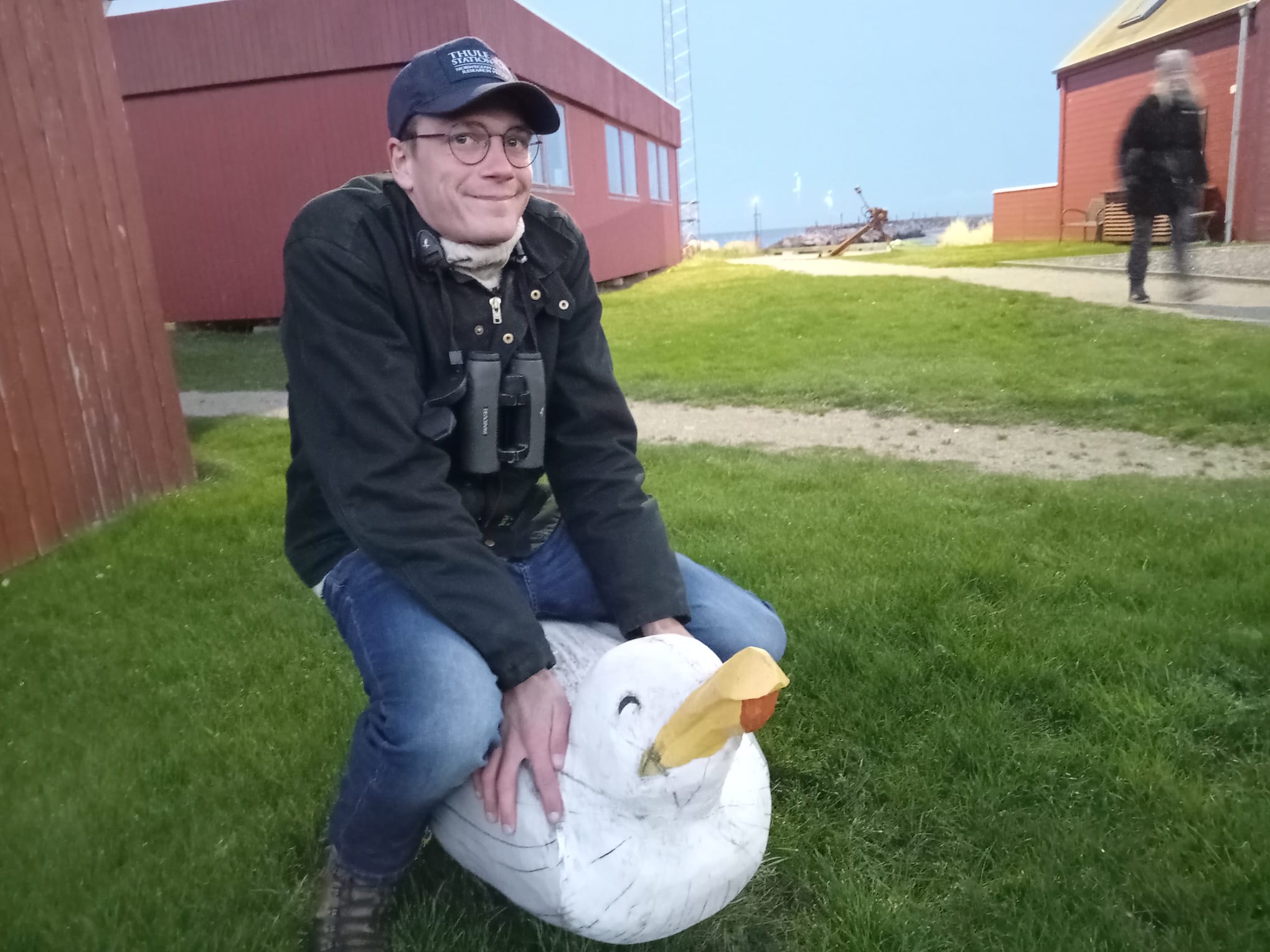 Ragnar thinking about how to steal it and bring it with him back home
Ragnar thinking about how to steal it and bring it with him back home
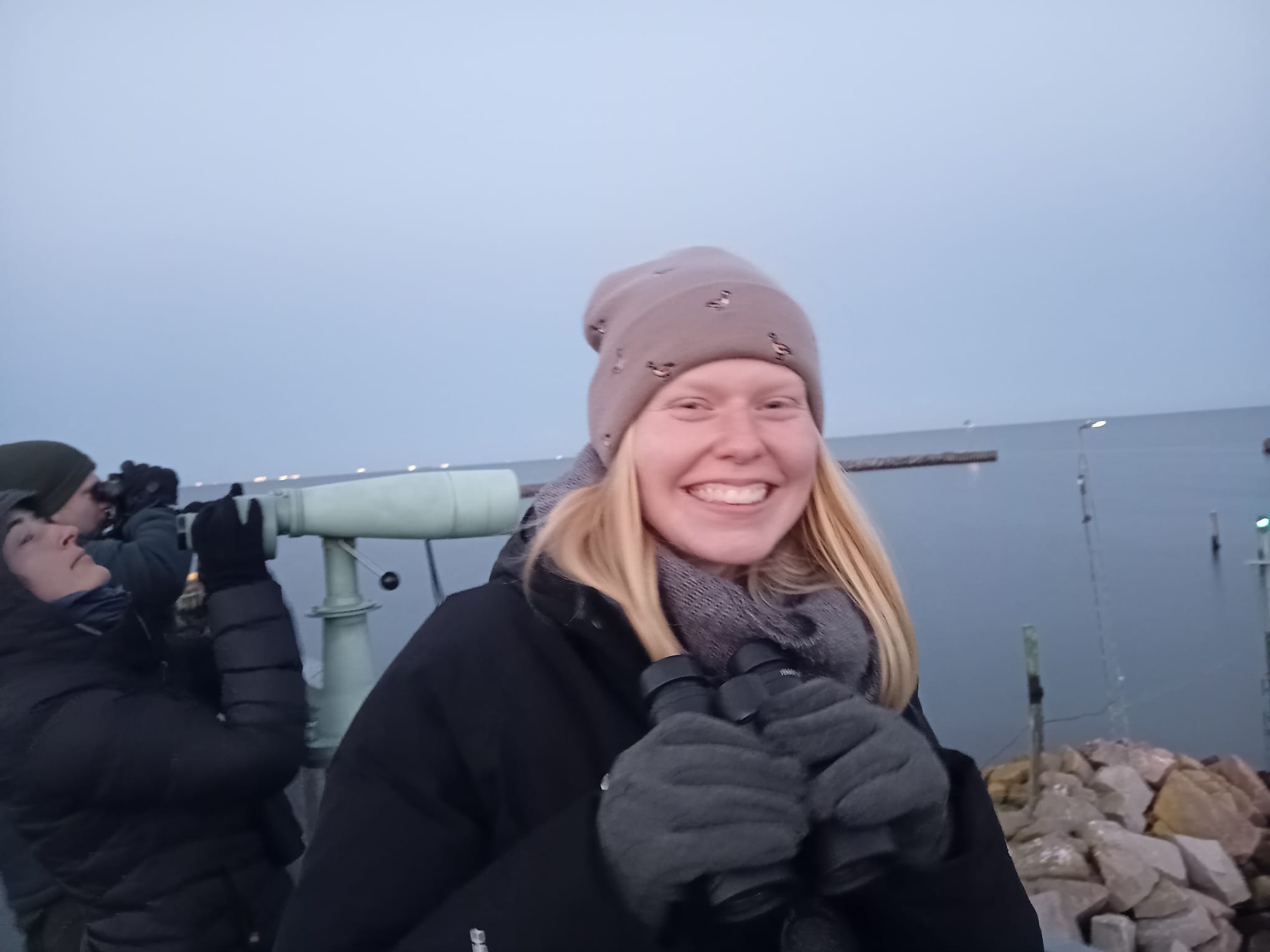 Mara realising that we don't have to wake up early tomorrow
Mara realising that we don't have to wake up early tomorrow
But now the sun had set, and we drove north. First a quick drop by Simon’s new house where we got to see the chicken and the inside and then a shopping trip in Lidl, always great to shop at Lidl, 10/10. 11 hours later we were back at the observatory for a quick evening meeting, dinner and some Wingspan, what a day. Tomorrow its going to rain the whole day so we can sleep in.
Highlights from obs:
Little Auk – Søkonge
Caspian Gull – Kaspisk Måge 3
Highlights from the trip
Steppe Eagle – Steppeørn
Golden Eagle – Kongeørn
White-tailed Eagle – Havørn
Common Kingfisher – Isfugl 2
Marsh Tit – Sumpmejse
Giant Shrimp - Kæmpereje
Link to today's observations from observers in the area
People at the station: Thomas Weston, Emma Fabre, Mara Glane, Ragnar Smith, Simon Sigaard Christiansen.
Little Auk Day
This morning, I went to the obs with Ragnar. We cycled through the snow to World’s end III. It was a cold morning but sunny. We saw the usual species like the Kittiwakes (Ride), the Razobrils (Alk), the Guillemots (Lomvie) and the Scoters (Sortand). One Fulmar (Mallemuk) came by very close to the shore.
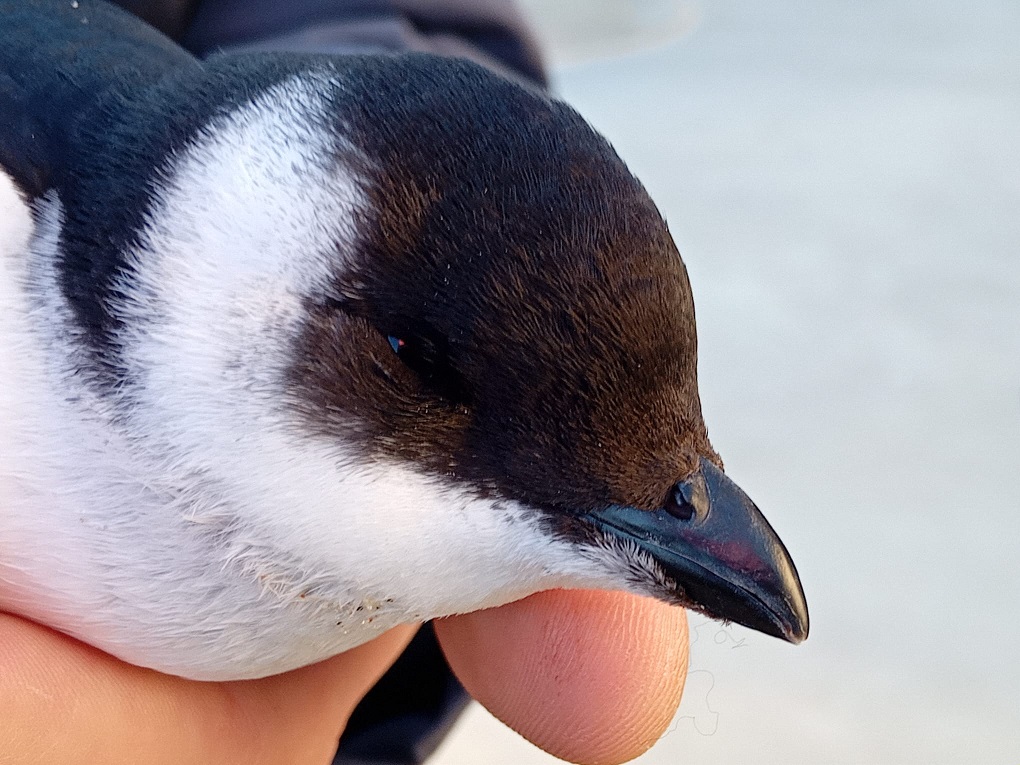
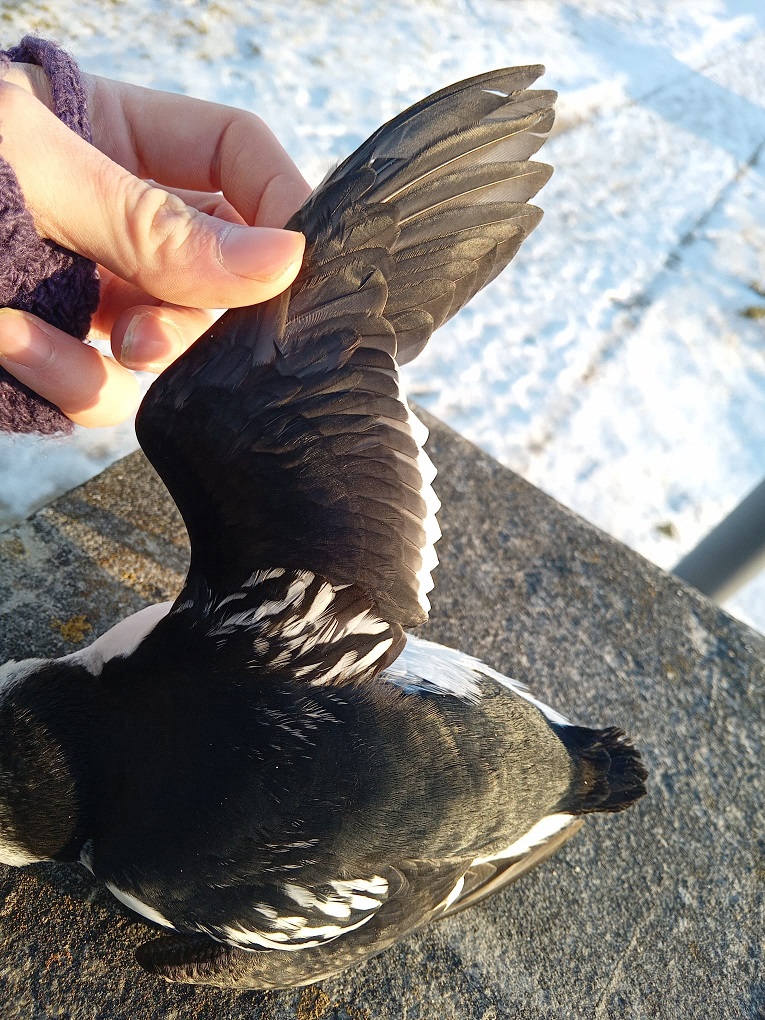
Dead Little Auk
We spotted a total of 5 Little Auks (Søkonge). Some of them were close to the shore. Two of them landed on the water for a while, giving us a very good observation. We also saw a Puffin (Lunde) and two Black Guillemot (Tejst).
In the middle of the morning, two tourists came to talk to us. So Ragnar began to explain migration to them, we still looked into our scope. Then, on of them stopped Ragnar and said “no we found a bird on the beach, look”. He actually had a bird in his hand, a Little Auk (Søkonge)!!! The bird was very tired. It needed to go to the rescue center. Ragnar put it in his hat and cycled quickly to the light house. Unfortunately, the bird was dead when he arrived. It is a very fragile species, so this was to be expected.
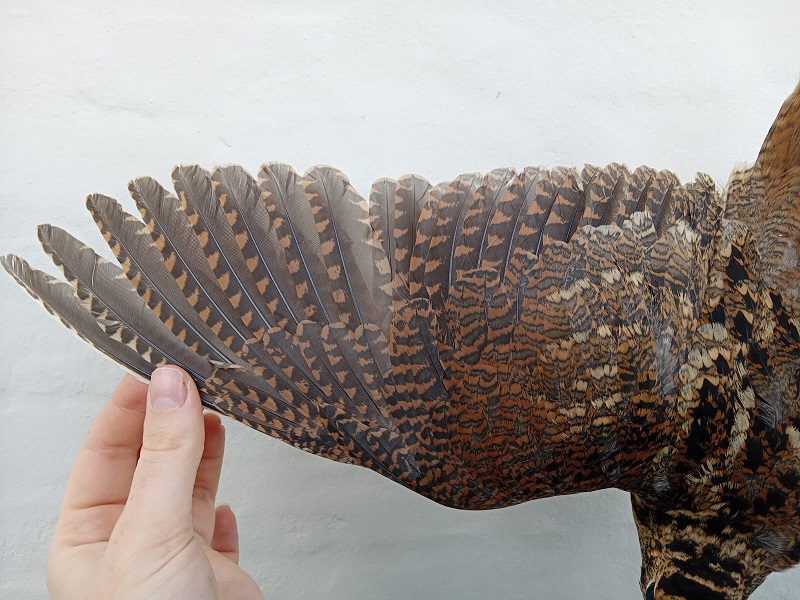
1st Calander year Woodcock (Skovskeppe)
Mara and Thomas opened the nets in the lighthouse garden. They caught 3 Blackbirds (Solsort) and 3 Wrens (Gærdesmutte). They also ringed a Woodcock (Skovsneppe). In between net rounds Thomas scanned the sea with the scope. He saw a Black-throated Diver and a Purple Sandpiper. They also sewed some holes in the nets from Kabeltromlen.
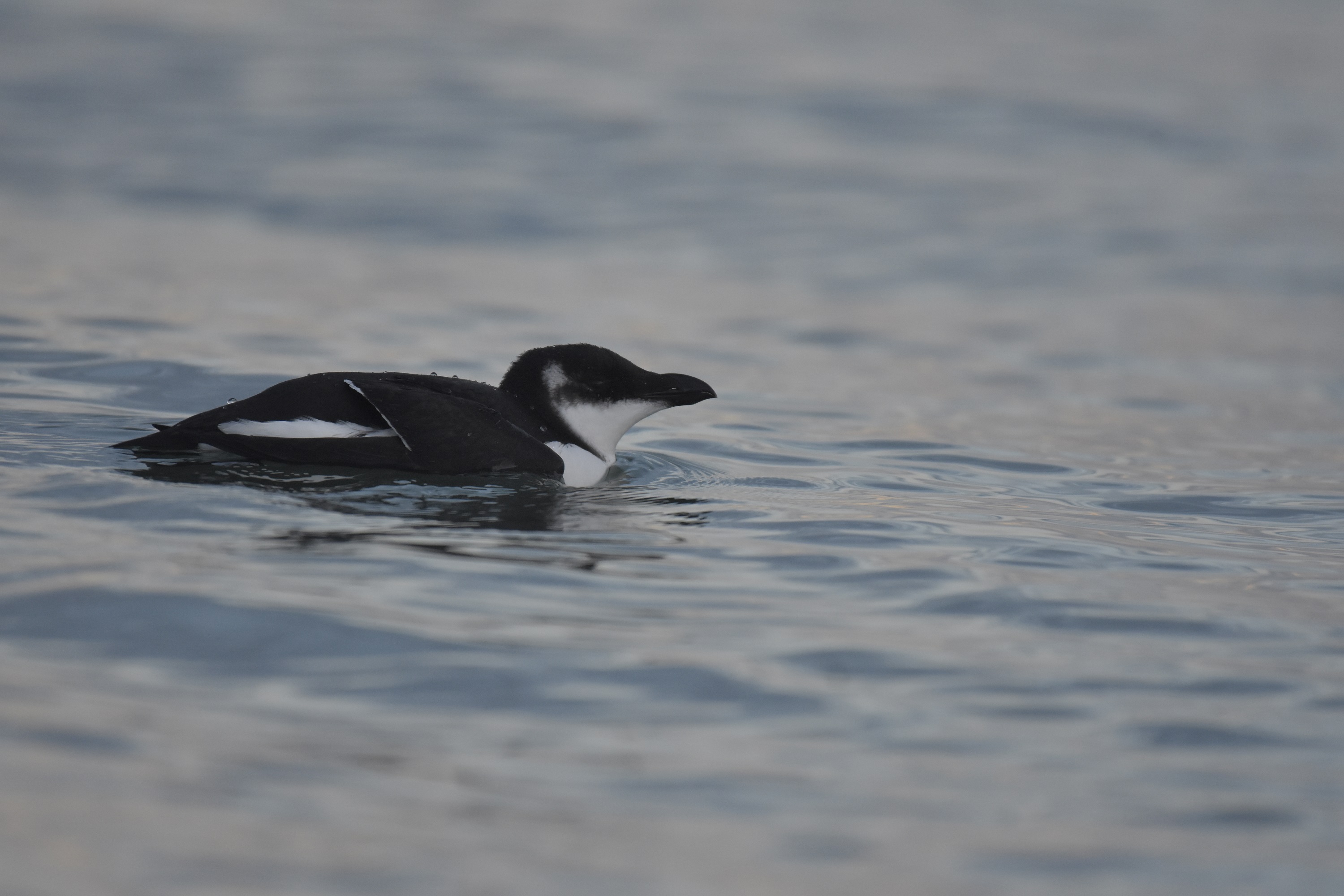
A young Razorbill (Alk)
In the afternoon I went for a walk and I found a nice young Razobril (Alk).
Ringing (Grey lighthouse):
Woodcock/Skovsneppe - 1
Brant/Gærdesmutte – 3
Blackbird/Solsort - 3
Goldcrast /Fuglekonge- 1
Highlights from observations:
Atlantic puffin/Lunde – 1
Little Auk/ Søkonge - 6
Today’s observations on Dofbasen from observers in the area
People: Thomas Weston, Emma Fabre, Mara Glane, Ragnar Smith, Simon Sigaard Christiansen.
